Boat Profile

O’Day Day Sailer
A proven performer for 61 years
From Issue July 2019
T he production of small boats was booming in the 1950s on both sides of the Atlantic, and really took off in the late ’50s with the introduction of fiberglass. Famed designers Uffa Fox and George O’Day teamed up in 1956 to create the O’Day Day Sailer. Fox is credited with introducing the technique of planing to dinghy racing and designed many significant classes of boats, including the International 14. The story goes that Fox wanted a pure racing dinghy but O’Day wanted the small cuddy added to increase appeal to the recreational market in the U.S., so Fox designed the planing hull and O’Day designed the cuddy. The resulting Day Sailer was a 16’9” centerboarder with a displacement of 575 lbs, which makes for a light load to tow behind the family car. The fractional sloop rig includes a generously sized spinnaker for exciting downwind sailing.
The first Day Sailer was sold in 1958 and immediately became popular in the recreational and racing markets. It was later designated as the Day Sailer I as four different models have since been built, with over 10,000 boats hitting the waterways. Day Sailer (DS) models I through III have been built by eight different manufacturers, with the current Day Sailer being a modified DS I with a few DS II attributes, such as the internal foam flotation and cuddy thwart. The original DS models I, II, and III were built from 1957 to 1990 by the O’Day Company in Fall River, Massachusetts. The DS I and modified versions of it were later built by Can-AM Sailcraft, Rebel, Spindrift, Precision, McLaughlin, Sunfish/Laser Inc. The current builder of the DS I+ is the Cape Cod Shipbuilding Company (CCSC) in Wareham, Massachusetts, holder of the exclusive license since 1994. The Day Sailer Class Association owns the molds that are currently used by CCSC.
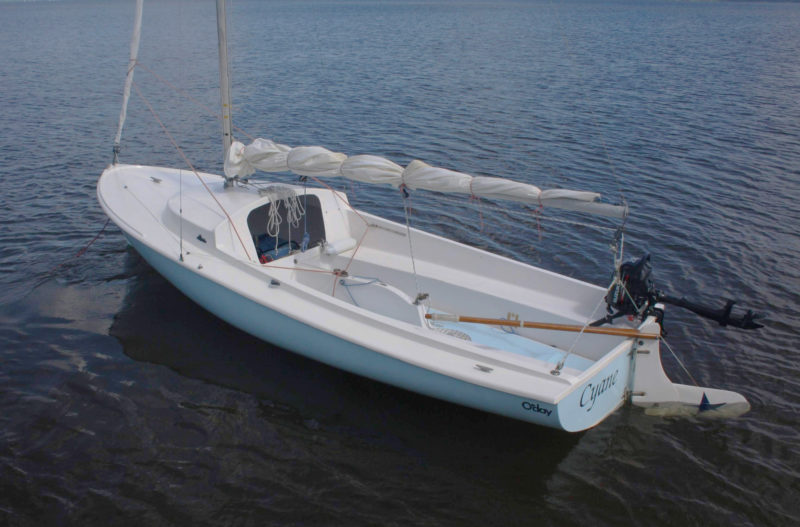
The long side benches in the cockpit provide uncrowded seating for six. The sole is above the waterline and is self-bailing.
The early DS I can be identified by wooden thwarts, seats, and cockpit sole, a centerboard lever, open cuddy, and a transom deck. The DS II came out in 1971 with built-in foam flotation. The cuddy opening is smaller than the opening on the DS I because it also acts as a thwart, and a thinner transom allows mounting a small outboard motor without the need for a bracket. The Day Sailer I and II are considered class legal for one design racing, but the DS III is not considered race-legal due to higher freeboard on the transom, which was a departure from Fox’s hull design. O’Day built the III from 1985 to 1990, so to race in One Design regattas it is important to buy a DS I or DS II. The current Day Sailer in production is a modified version of the DS I with improved self-rescuing capabilities, two sealed air tanks, and a cuddy flotation tank with a smaller hatch.
The Day Sailer, no matter which model, is a very versatile boat, easy to rig, sail, transport, and store. With the mast down the boat and trailer take up just a few feet more than an average family car, so can be stored in most garages, though the mast may need to be stowed diagonally. At the ramp, the Day Sailer can be rigged in under 30 minutes: step the mast, add the boom, bend on the jib and main, clip the pop-up rudder onto the transom, and sort out the sheets.
Stepping the mast is the biggest challenge. The 23′4″-long racing mast is stepped through the top of the cabin onto the maststep fixed to the floor of the cuddy, and that can be tricky for one person. The mast does not weigh much, but it is helpful to have a helper at the foot of the mast to guide it into the cuddy opening. The good news with this arrangement is that once the mast is stepped, it is secure, and there’s no rush to attach the forestay.
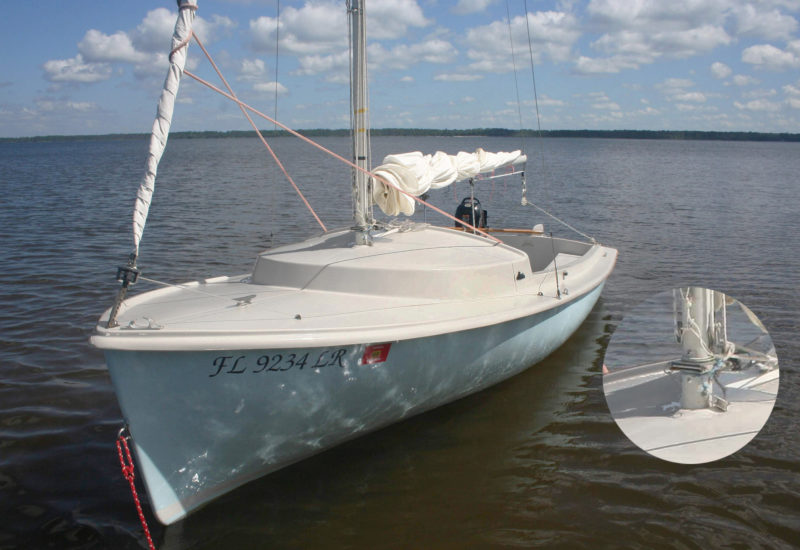
A mast hinge, a popular option, makes raising the mast much easier.
About 75 percent of the new boats are delivered with a hinged mast, eliminating the awkward gymnastics of stabbing the mast through the cuddy. Once the mast is raised and the forward hole on the hinge pinned, securing the forestay to the bow fitting takes the strain off the hinge. Side stays can then be tightened to take out the slack, but no more than hand tight. Stays that are too tight can damage the hull. Tighten the nuts on the turnbuckles and tape over any cotter pins.
There are different sheeting arrangements for the boom. Some boats have sheets attached in the middle of the boom; the sheet on a DS II starts from a traveler on the transom and ends forward on a swivel cam cleat mounted to the centerboard case. The DS II boom also has a spring in the gooseneck that allowed for roller furling— disconnect the sheet, pull the boom aft, and roll the sail onto the boom. A reefing claw has to be added to connect the sheet to the sail-wrapped boom, but this design is not optimum, nor is the wad of rolled-up sail by the boom’s gooseneck. A better arrangement is to add a conventional set of reefpoints to the mainsail. The boom also has a vang to improve sail control.
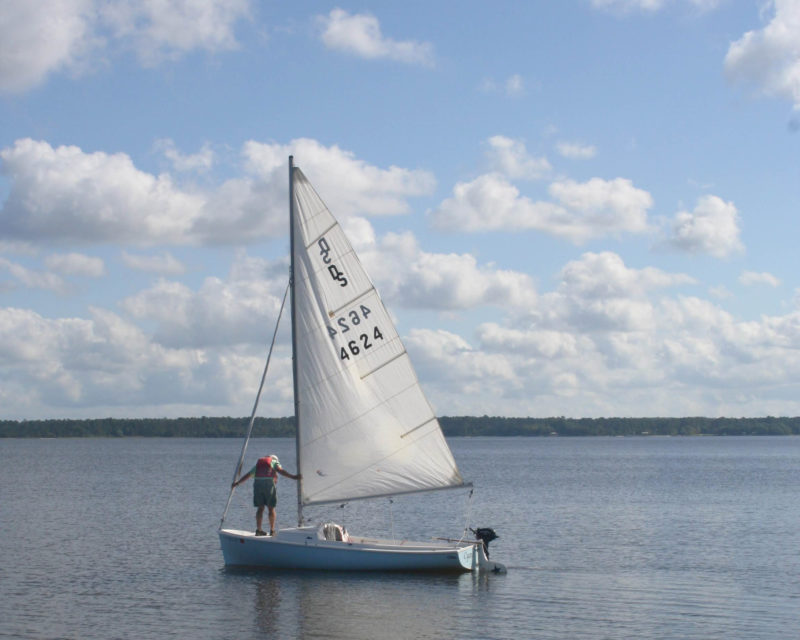
The 6′ 3″ beam gives the Day Sailer good stability, enough to keep the boat under someone standing on the foredeck.
The jib on the racing version of the DS is a standard affair, attached with hanks onto the forestay and raised with a halyard. Some skippers add a downhaul to lower the jib from the cockpit. Both the main and jib halyards are led aft on the top of the cuddy. The recreational version of the new DS I comes with a roller-furling jib, which we consider essential for sailing dinghies, especially if singlehanding. We have added a roller-furling jib to our DS II along with the mast hinge. We also added the hardware and rigging for a spinnaker, halyard, spinnaker pole, spinnaker pole control lines, sheet blocks, and jam cleats.
T he Day Sailer is a treat to sail; it handles well, tacks with ease, and powers up quickly with its large sail area. The planing hull is responsive to the tiller, and the wide beam makes it stable. The boat will roll quickly but then sets on a tack, holding it with stable and positive helm control. The centerboard can be easily adjusted from amidships.
We sail a Drascombe Lugger and a Sunfish; the Lugger drives like the family sedan and the Sunfish like our Mustang. The Day Sailer handling is closer to that of the Sunfish—when the breeze picks up, the mainsheet needs to be held in the hand and someone should be ready on the jibsheets. The jibsheets run through the coaming on the DS I and through small cars on the DS II. For the highest performance, skippers have added tiller extensions and hiking straps. There is an outhaul on the battened main; racing versions have barber-haulers and travelers added. Pop the spinnaker, and it will scoot along quite nicely in a light breeze.
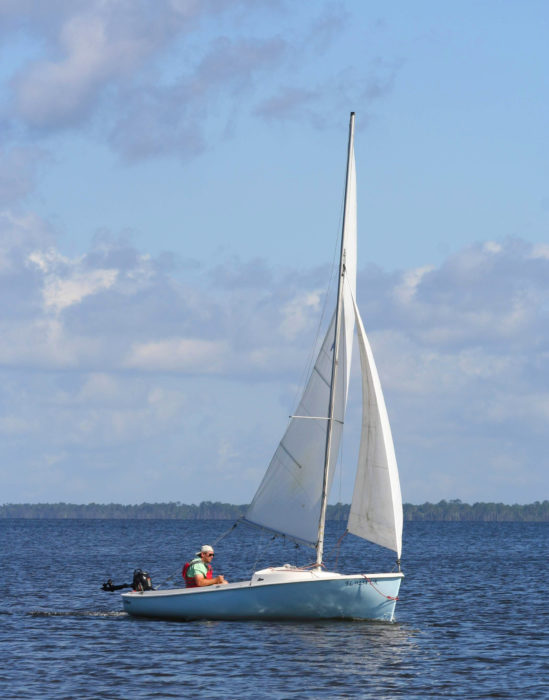
The Day Sailer carries 100 sq ft in the main, 45 sq ft in the jib and, for sailing off the wind, another 95 sq ft in spinnaker.
The Day Sailer’s 7′ 4″-long cockpit provides plenty of room for three adults, or two adults and two kids. With four adults it gets cozy; there is not much moving around, so whoever is sitting next to the tiller or foredeck needs to know what to do. It is easy to depower the main, reef it, or furl the jib as needed.
The cuddy is spacious for storing picnic or camping gear, and it affords a space equivalent to a two-person backpacker tent for sleeping aboard for overnight cruising. Adding a topping lift makes the boom nice ridgepole for a boom tent; there’s plenty of room to sleep in the uncluttered cockpit. The Day Sailer has completed many endurance cruising events, such as the Texas 200, Florida 120, and the Everglades Challenge.
A small kicker can be added for auxiliary power. We have used both an electric trolling motor and gas outboard, with best results coming from a 2-1/2-hp four-stroke that pushed push the boat to 6 knots at one-third throttle. The DS I will require a bracket to support and outboard; the DS II transom is thin and sturdy enough for a direct mount. If we’re not going far from home, we occasionally skip the outboard and carry a paddle; with her low coaming we have paddled her a bit, even backward over the transom.
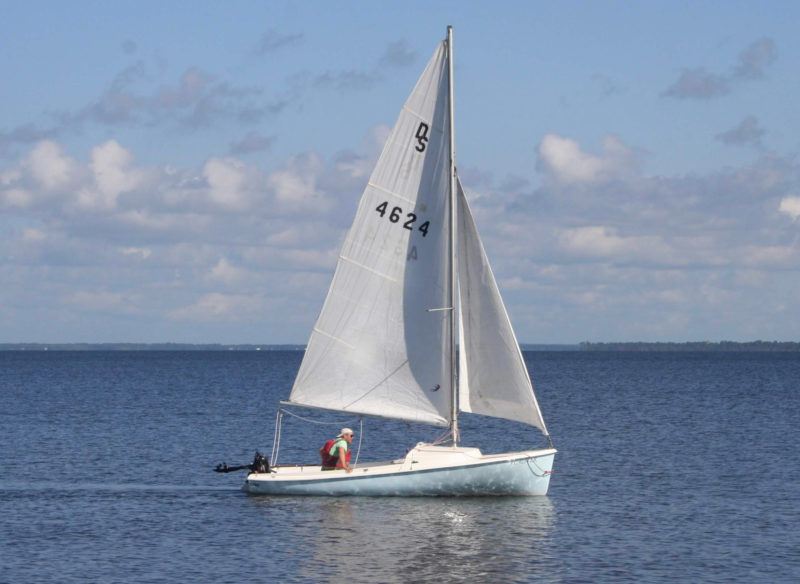
The transom of the Day Sailer II will accommodate an outboard for auxiliary power. The Day Sailer I will require a bracket.
D ay Sailers are easy to find and inexpensive, considering their capabilities. If you come across one, there are few important things to check. Make sure the centerboard moves in the trunk, see that the forestay tang and bow seam are not pulled up, inspect the cuddy deck for noticeable depression which would indicate failure of the maststep under the cuddy floor, and if it is a DS II look inside the flotation compartments. Rinse her off and get her ready to sail. There is a great Day Sailer Association with a web-based forum, and excellent parts availability.
Audrey and Kent Lewis enjoy time with CYANE, along with their small fleet of kayaks, canoe, sailboats, and lapstrake runabout. They blog about their adventures on smallboatrestoration.blogspot.com
Day Sailer Particulars
Length/16′ 9″
Draft, board up/9″
Draft, board down/3′ 9″
Displacement/575 lbs
Main/100 sq ft
Jib/45 sq ft
Spinnaker/96 sq ft
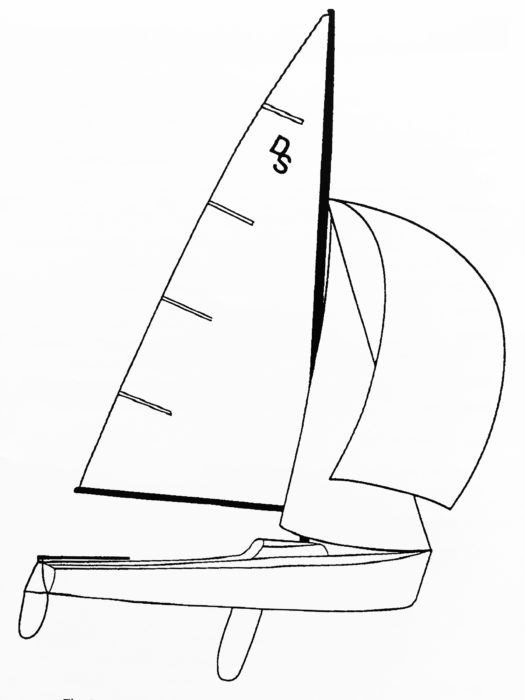
The Day Sailer is built by Cape Cod Shipbuilding Company . Prices start at $18,335 (less sails). For more information about the Day Sailer Class, visit the Day Sailer Association .
Is there a boat you’d like to know more about? Have you built one that you think other Small Boats Monthly readers would enjoy? Please email us!
Share this article
Join The Conversation
We welcome your comments about this article. If you’d like to include a photo or a video with your comment, please email the file or link.
Comments (35)
Great article Kent! I have a sister to your boat, right down to the racing mast and blue hull!! But since we’re moving to the Pacific NW, I’m about to sell it. I’m limiting myself to only 3 boats for the move (and it’s a hard sorting out!!!!). Great write-up about a fantastic boat! Thanks! Charlie
My father was George O’Day. It is nice to know the basic design that my Dad helped create is still vibrant 60 years later. I always find it interesting since Dad was a pure racing sailor that he designed a boat and saw the importance of appealing to the recreational aspect of sailing. He wanted to open the door to the bigger audience to share his passion of sailing.
I sailed with your father on a Hobie 16 at a Red Cross small craft instructor program. So much fun sailing with a legend.
Charlie we know it’s hard, the Day Sailer is such a timeless boat. If she has to change skippers, find her a good one.
Miss Beth, so wonderful to hear from a family member, it must have been quite an adventure to grow up around boating and racing. That Day Sailer hull was Cap’n Jack’s favorite, we enjoyed looking at it. Thank you for the insight into your family’s history.
Cheers, Skipper and Clark
I’ve had an O’Day for years, my first sailboat. I love sailing her around our little lake.
This boat is the best for a small family. In Brazil it’s a great option.
O’Day DS was my first brand-new boat. I was a “veteran”of maybe six months sailing in the late 1960s and she taught me to love sailing.
Great boat design. I’ve sailed different ones on and off over the years. Still a favorite.
Beth, your father made great boats as my father still has an O’Day 20 he bought new in ’76 and it’s still like new and a great sailing boat!
I recently bought a 1966 model after downsizing from a Viking 28. My father owned a Rhodes 19 and we sailed that boat for years on the western end of Lake Ontario. The design was similar, so the transition to the 16 was easy. I love the boat because even in high winds I can make a simple adjustment to the main with reef points. Solo sailing is fun and safe. I can see why so many were sold.
Hello, I just bought O’day sailboat. I do believe from what I’ve been reading that it’s a Daysailer 1. I was told this boat has never been registered and never had a kicker motor on it, I can’t find the metal tag on the transom but I see the two rivet holes where it should have been. Is there any other place on this boat to find the serial number? I would like to put a kicker on it and register it and, if not, is there a way to register this boat? Thank you for helping
The requirements to register a small boat that has not been registered before is different for each state. In NY, a boat is registered through the DMV. HIN numbers are placed on the right side of the transom. If you do not have one your boat was made prior to 1972.
Thank you for the reply, I’m working on getting a HIN number now.
Check with O’Day. Some manufacturers hide a second HIN onboard. Worth a shot.
My boat has a plate on the inside toward the front of the boat. On the bulkhead (might not be the right term) behind the mast. You’ll have to crawl into the cubby to see it. It’s a little plate 2″ x 4″ and shows Hull no. and Class no. The paperwork I have says the boat was made in 1967. Does anyone know the difference between Hull number and Class number?
Can anyone give me today’s value of a 1960 O’Day Day Sailer, #333, with a small motor that goes on the mount with sails that all sit on a Dilly trailer? It has all the original woodwork that my husband redid. It does not have a spinnaker but has the jib and main and a Proctor mast.
My daughter and I are looking for an older (less expensive) sailboat. Not sure where your at , we are South of Boston. The O’Day is our first choice. If you are going sell, please reply to this comment. Thanks
[I’ll connect sellers to John. Ed.]
16′ O’Day Day Sailor with trailer and motor
2013 DS for sale in Sharon,MA. needs work on floatation tanks
At 30 years old, I just bought my first sailboat which is a 1965 DS I. The boat has sat for a few years and she needed a good power-washing plus painting of the hull and inside the cubby and several new lines. I’m completely inexperienced with sailing (plenty of time cleaning boats, though) and couldn’t be happier to learn on such a beautiful vessel. Thanks for this article! It’s great to get some background info. Plus, plenty of words to highlight as I expand my boating vocab.
Day Sailers are easy to find? I guess you know where to look (certainly no offers in Craigslist). I have not been lucky enough to come across a good one that is 10 to 20 years old. I live in Massachusetts. Would you mind sharing where to look for one?
I have an O’Day day sailer 16.5 ‘ up for the taking. Our family had years of good times sailing and camping with It. Great family boat. Wooden seats and rails. Needs some work. In central Massachusetts
I am assuming you have gotten rid of your O’Day day sailer – if not, I may be interested. I’m new to sailing at 57 years young! I just took lessons at KYC here in Blue Hill, ME and am looking for a great starter boat that I can learn in and have fun on the bay.
Thanks, Kelly
Actually, I just bought a 1989 DS2 from Craigslist, on trailer, for $300. It needs only minor work and a lot of cleaning. I hope to float it Saturday to see if it sinks like a rock (I know it has flotation), and will need glass work, but I could see nothing amiss while on the trailer.
So, never say never.
Hi Laranja, I just read your comment about trying to find a used O’Day Day Sailer. I live in Wareham where Cape Cod Shipbuilding is located, they are the current builders of the Day Sailer. They usually have used boats available. I have a 1971 DS, a wonderful boat.
I have a 2013 DS for sale in Sharon,MA. needs work on floatation tanks
Fantastic article
Interested in purchasing a fine example that was actively sailed
I agree with the many positive comments above. Great article! I was a longtime owner of an O’Day Widgeon (14′), and after many boat-less years I’m pleased to have purchased a 1984 O’Day Daysailer II just last week. It’s in good condition, and after sourcing a few needed part, I’ll enjoy it on lakes here in Georgia. Thanks for the great article, which has served as an orientation of sorts for me as to what to expect when I launch her for her maiden voyage under my ownership. A long-time marketing and sales executive, I’m naming her SAILS CALL!
I just got a DaySailer, thought it was a 67 DS1 but the transom is thick with a box on the port side by the transom so not sure now DSII?
I just today bought and brought home to MA a 1966 O’Day Day Sailer (as shown on the registration from NH), and it has a thick transom with lidded box on the port side. Also has a wide cuddly opening and wooden cowling and thwarts as described above for a DSI.
We’re down sizing from a 53′ Pearson to an O’Day 18 that someone offered us. I have no qualms about the sailing, but the temperature of the water here (Massachusetts to Connecticut) worries me very much, after a lifetime in the tropics. Are these dry boats when sailed conservatively?
I have a 2013 Cape Cod built DS for sale in MA. Needs some work on floatation tanks.
I just sold our Venturer 22 and picked up (rescued) an O’Day 16 DS. A couple weeks in the shop and it looks ready to sail. One question: the roller reefed main (boom) does not “lock in.” I suppose I could jiffy reef it but does anyone have experience with the roller reefing boom? Am I missing a part (the claw) or do I just not get it.
I want to buy an O’Day sail 17′
We have a 1976, 17′ foot O’Day DSll (?) on trailer that we are transferring to another family member. We are trying to figure out the best way to get it from Oregon to New Hampshire. Any ideas out there?
Leave a Reply Cancel reply
Your email address will not be published. Required fields are marked *
Stay On Course
More From This Issue

From The Editor
Suitable for Framing
here’s an interesting exhibition of art at the Georgetown Historical Society in Georgetown, Maine. Some of the pieces on display are an unusual pairing of abstract painting and wooden boat...
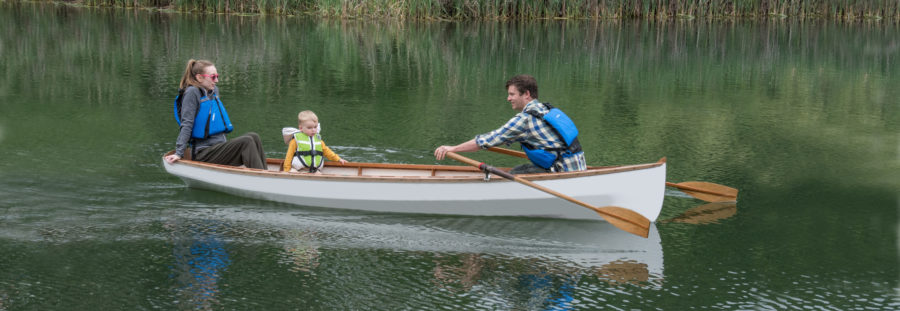
Whitehall Tender
Shenandoah Whitehall
The construction went quickly. Every major project I’ve ever begun has a hidden “gumption trap”—a difficult and unrewarding challenge that sucks the will to persist right out of me. This…

The Day Sailer, no matter which model, is a very versatile boat, easy to rig, sail, transport, and store. With the mast down the boat and trailer take up just…
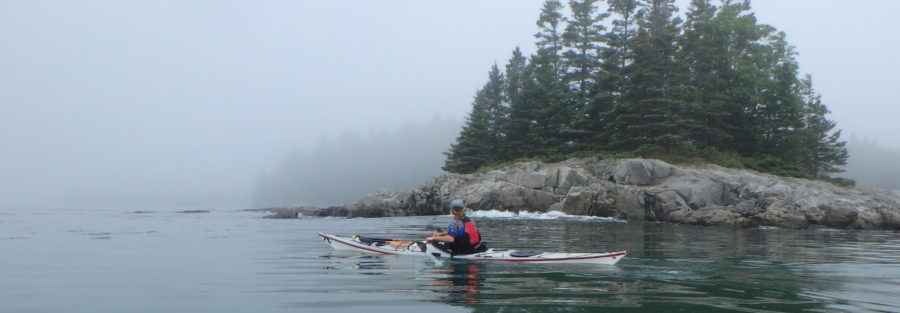
Dallying Downeast
We’d started at Deer Isle, where we had lived and worked for 14 years, and we planned to paddle a big figure-eight: first down to Portland and back, and then…
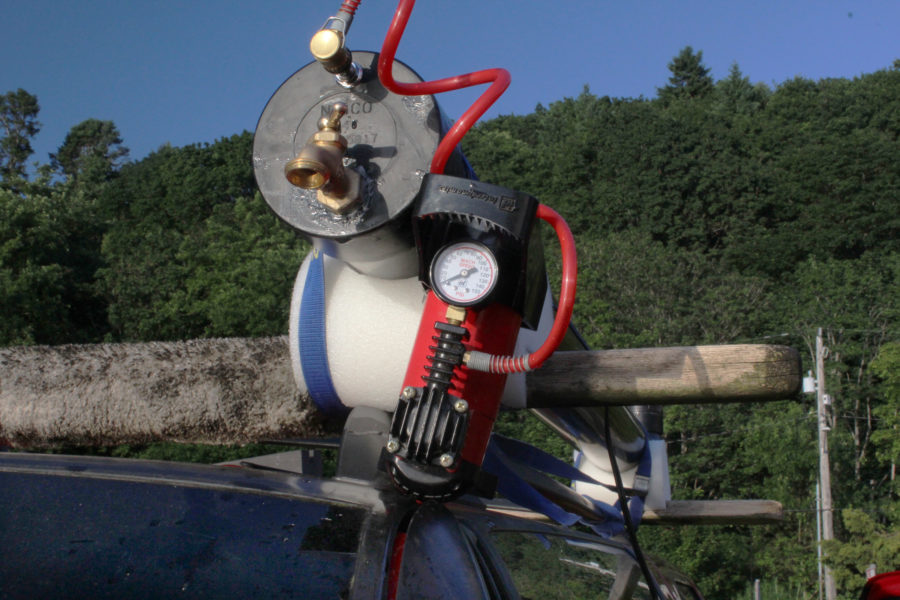
A Cartop Water Tank
Bringing the pressure up to 40 psi is sufficient to propel the remaining 4 gallons of water out of the tank. The nozzle I have on the hose will shoot…
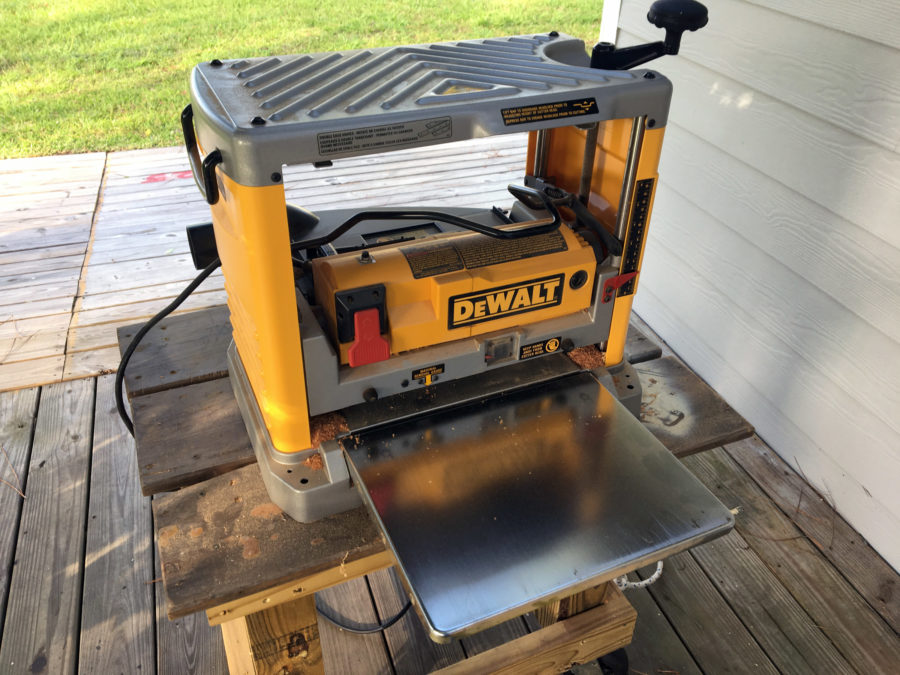
Product Reviews
DeWalt’s Benchtop Planer
We researched benchtop planers and decided the DeWalt DW734 would meet our requirements. Its 12-½” wide bed could handle the 12”-wide garboard that we needed to replace, and its 6”…
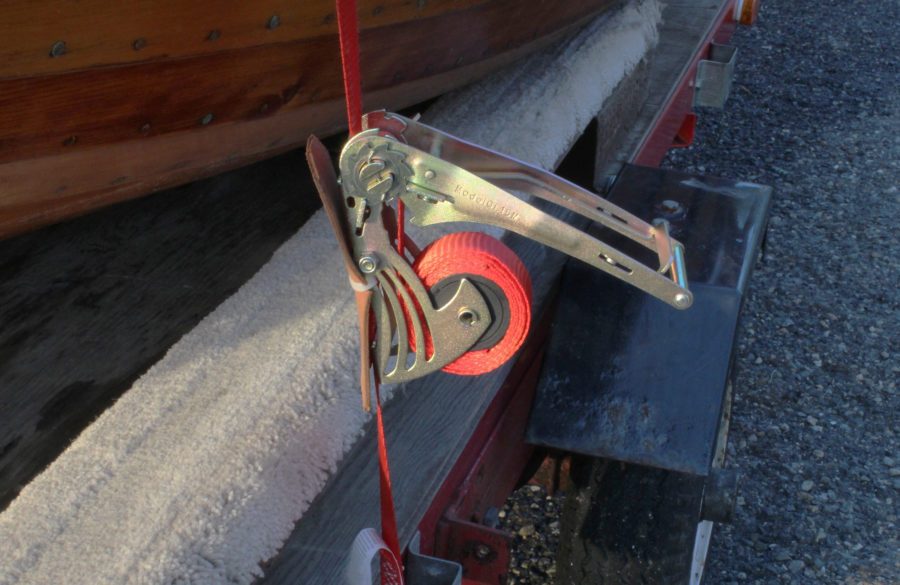
Quickloader Retractable Ratchet Straps
The QL15 model has two black, rubber-coated metal S-hooks, one of which is on a 9-1/2” piece of 1” polyester webbing, and the other is at the end is a…
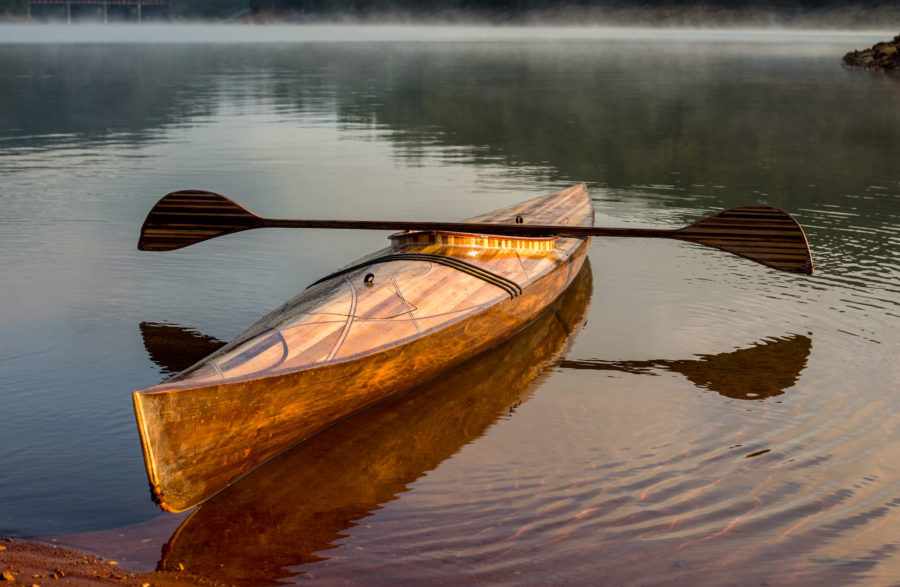
Reader Built Boats
DREAM WEAVER
Neither Claudia nor Jacob came into that class with much experience in marine design beyond scanning online videos and blogs. For guidance on construction they studied Nick Schade’s The Strip-Built…
More Boat Profile
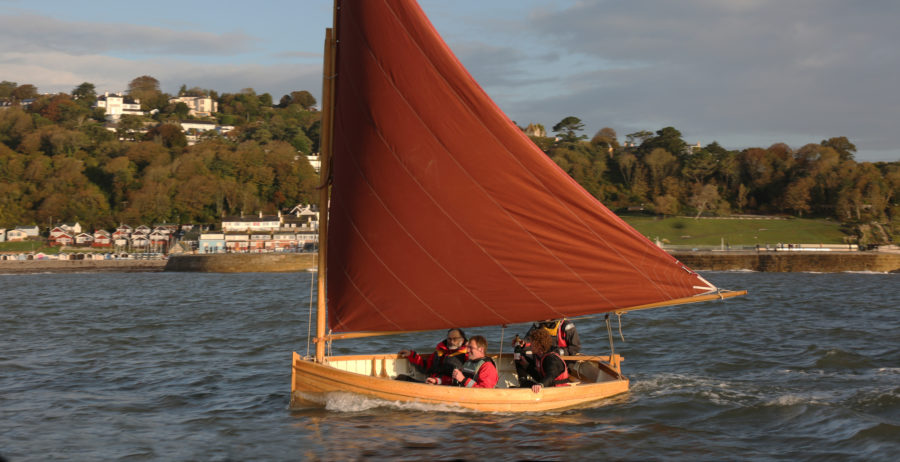
At one point the Droleen touched 5 knots in a gust on a close reach while the centerplate hummed satisfyingly. The massive beam gives the boat not only a great…
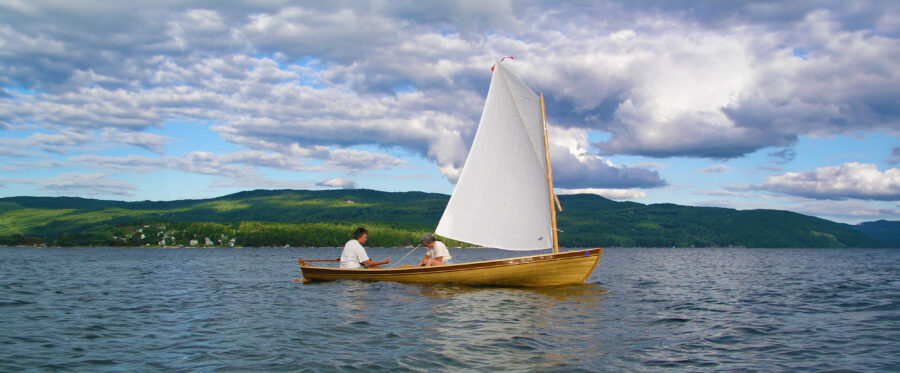
Newfound Wherry
When the Newfound Wherry was resurrected in the fall of 2022, I built the updated version—equipped with a daggerboard and a larger spritsail—I bought the plans and complete kit provided…
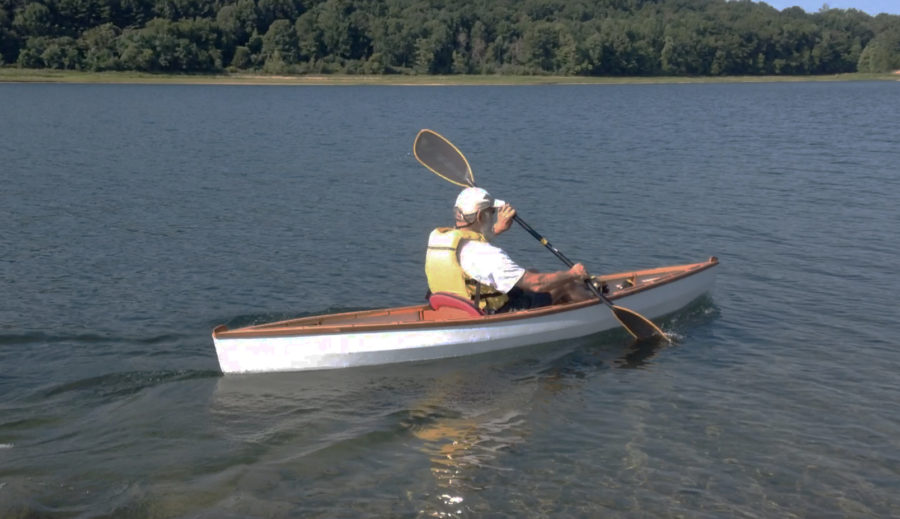
I already had a sailing dinghy and a sail-and-oar skiff in our two-car garage, but I thought there was room for one more boat, a small one, alongside my wife’s…
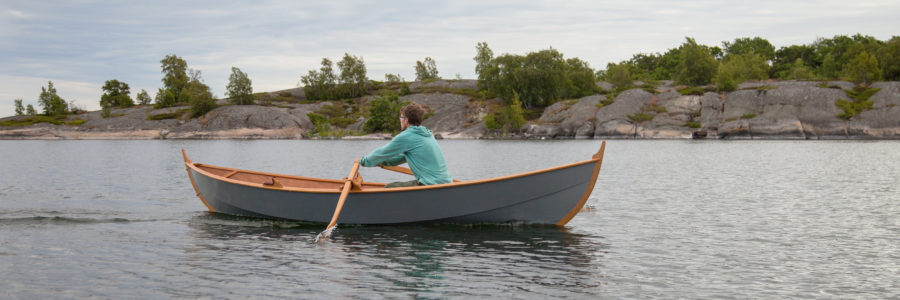
The original faerings were built by hand and eye, and had slowly evolved during hundreds of years to meet the local conditions and particular purposes. Iain carefully studied every design…
Subscribe Today!
Become a subscriber today and you’ll recieve a new issue every month plus unlimited access to our full archive of backlogged issues.
Already a subscriber? Sign In
Subscribe For Full Access
Flipbooks are available to paid subscribers only. Subscribe now or log in for access.

- Forums New posts Unanswered threads Register Top Posts Email
- What's new New posts New Posts (legacy) Latest activity New media
- Media New media New comments
- Boat Info Downloads Weekly Quiz Topic FAQ 10000boatnames.com
- Classifieds Sell Your Boat Used Gear for Sale
- Parts General Marine Parts Hunter Beneteau Catalina MacGregor Oday
- Help Terms of Use Monday Mail Subscribe Monday Mail Unsubscribe
Frustrated---O'Day Daysailer 17'
- Thread starter Windtherapy
- Start date May 29, 2017
- Oday Owner Forums
- Day Sailers
Windtherapy
So refurbished my entire 17' this winter in my pole barn. First day to pull out and set the brand new sails in the yard and adjust everything. Why, why, why can't I get the main high enough to get the foot of the sail tight? I pulled as hard as I possibly can on the halyard and dropped the boom as low as it can go without taking out the cleat for the Cunningham line and still I need a few more inches to get the foot tight. What am I missing here? Brand new sails from Intensity. Oh and last year when I took it out right after I bought it the boom was MUCH high than it is now. Right now even with the foot loose by about 2 inches and the boom being lowered as much as possible, the boom would hit me in the neck and I am only 5' 11". Last year with the old sail the boom cleared my entire head. IF I ever wanted to install a vang there would be no room. The boom now is about a foot off the deck. I don't get it. Even if I crank the living h*ll out of the shrouds (which I didn't do) it would maybe give me another 1/2" at most. Am I missing something here? The new jib is fine though.
LeslieTroyer
sounds like your new main is cut a little long - Les
Did you loosen your vang or whatever holds your boom down? I know on my Hunter 280, I had some wrinkles in my main that made me think my sail was really stretched out. Then I loosened my vang and raised the sail, then tightened the vang. Made a huge difference. I hope you get it figured out, but get out there and sail. Greg
Just a few questions: 1. How was the luff dimension (to make the sail) determined? For example, was the dimension based on the published class sail measurements? 2. Does the head of the sail reach the full height? 3. If the dimension was based on class sail measurements or specifications, then the mast should be checked for the proper class dimension (length). If that is on spec then the boom appears to be in the wrong location. 4. If you didn't buy the boat new perhaps the previous owner used a different sail (non O'Day) or had the sail recut thereby loosing some luff length. Editorial comment: the Daysailer is a decades old class so maybe something has changed over the years, like the mast length. Maybe the newer masts are taller? That was a very popular model so hopefully someone will chime in. I think the longest aluminum mast extrusions used to be 21-feet (from Dwyer in RI or MA, and I don't know where their masts came from but this was a popular mast supplier) so maybe they found a way to get a longer extrusion. Disclaimer: I don't know really anything dimensionally about the O'Day Daysailer except that I know how it looks. As an aside, I'm not sure what how your height factors into the equation. On a 17-foot daysailer I'm sure that the boom will be low so if sitting down it wouldn't surprise me if one has to duck your head when you tack. A Daysailer owner can correct me on this if I'm off in this statement. If one want's a higher boom then there will be a loss of sail area. I've skippered (as a fill-in) a Hobie 33 and we had to duck our heads on it, but then every boat is different. Another possibility is that the leach dimension is shorter and that would raise the end of the boom and give more head clearance, less sail area, but have no effect on the tack.
Good points all. FYI--no boom vang installed yet. Talking about the mast, good point. Rudy at D&R stated I have a racing mast with stiffeners and the mast head sheave I have he has never seen so....maybe the sail is just about 2-3" inches too long. My luck. I'll sail it anyway and see what happens. I mean it's not too bad and maybe it will look better when I am out on the water sailing. I am still shocked on how low the boom is. Would lobe to have another DS1 post a picture of how low their boom is. The images when Googling the DS1 online are hard to really see that well. Do you really think a boom vang is tat important on a Daysailer? The photo on Intensity sails webiste of the DS1 main even shows a tad loos foot towards the mast side--exactly what mine is doing. Maybe I am WAY over thinking this but being a new sailer, I am not sure.
Attachments

So I took the old sail and laid it on top of the new sail (photo attached). What a difference at the foot. In the photo I have the head, tack, foot & luff aligned perfectly together. Hmmmmm?

Looks like Intensity Sails are designed to fit original set up DS's and not ones with the mast converted to the tabernacle system. Lovely!
something is very wrong with what you've got - John may be onto something, and you've got a pieced together rig. The DS has had essentially the same spec's it's entire life (I've owned and raced 3), and the boom is high for a 17 footer. Your old sail has a very strange foot shape, too. I've attached the DS1 assembly instructions from O'Day, and part 3 of the class rules which shows the rig dimensions.
- ds1man-oday.pdf 529.1 KB Views: 487
- dsbylaw3.pdf 254.5 KB Views: 327
I am imagining a lot of DS 1's have gone to the tabernacle system so unless somebody takes 2-4 inches off the mast while doing so, they are basically the same as original. Either way, I'll measure my mast tonight and see what I have. With that said, if I need to have the sail sewn to my boat specs, any good company that anybody knows of that could do this?
Windtherapy said: Would lobe to have another DS1 post a picture of how low their boom is. Click to expand

May not be the best option, but something to think about. When the wind pipes up one really does not want any wrinkles in the luff of the sail, so here is a thought. Discuss with the sailmaker (one that wouldn't get upset because you didn't buy the sail from him/her) about putting a flattening reef point above the tack. Shouldn't cost much and definitely cheaper than a re-cut. One option would be to have it where if the sail was re-cut later, should you decide to go that route, it could then be used as the tack, another option would be to have it a few inches above where the recut sail tack would be. It used to be that bolt ropes would shrink over time but I don't know what they're using nowadays. Of course one would need a line to go through the flattening reef point. Pad eye and cleat on the mast under the gooseneck? There may already be something there for reefing. Nice looking "Bottoms Up" boat picture!
Sunbird22358
A Boom-Vang is not absolutely needed I guess on a DS, but.... would I want to sail one without the vang.. NO!!!!!! I have wanted a boom-vang on every boat that I've sailed after the first time that I sailed boat that had one. It keeps the boom from lifting on a run or broad-reach reducing the risk (but not removing it) of jibing. The sail can be flattened mre in stronger winds helping to spill the wind better and reducing the heeling effect. Pictures that I've seen of early (late 1950's to early 1960's) DS Is do seem to show a higher boom, but as previously mentioned, the mainsail dimensions have not changed from 1958 to 2017, a Day Sailer sail is the same dimensions now as it always has been. (Class rules!) Are you able to get the head of the sail all the way to the top of the mast slot? Try raising the sail with the downhaul loose. What size (diameter) is your main halyard? Most owners use 1/4" line and most often a problem getting the sail all the way up is caused by either a kink in the sail slot or too large diameter of halyard (and the resulting splice to attach the shackle. One more possibility, try lubing the sail slob b rubbing some candle wax along the edges, or a dry spray lube could be used, but I prefer the wax. It is amazing what a difference that makes (and I still need to do that this year on my boat, launched last weekend for the season and realized today that I had forgotten this vital step! I do the boom slot too!)
- This site uses cookies to help personalise content, tailor your experience and to keep you logged in if you register. By continuing to use this site, you are consenting to our use of cookies. Accept Learn more…
Better Sailing
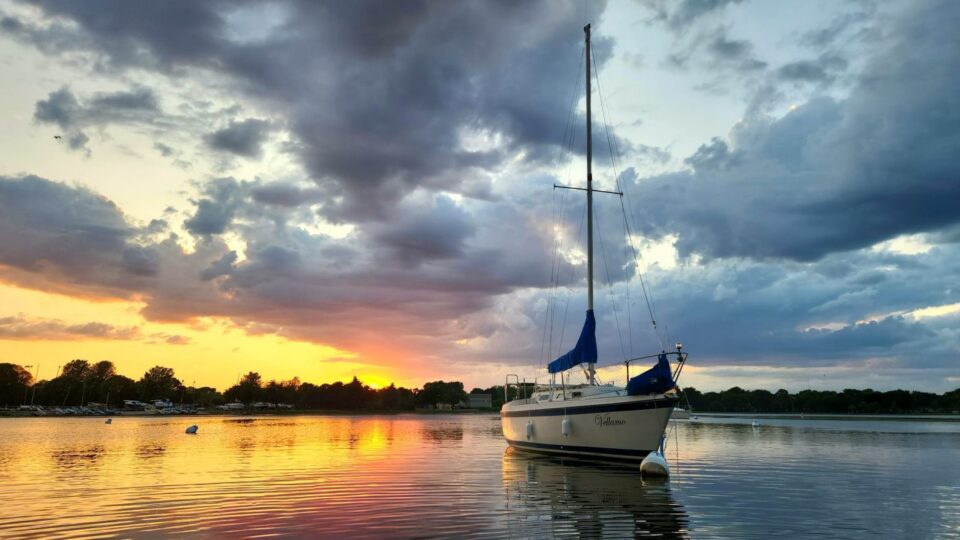
Are O’Day Sailboats Good? A Closer Look at a Classic Brand
For many, sailing is not just a hobby; it’s a passion, a lifestyle. It’s about the rhythm of the waves, the dance of the wind, and the thrill of the voyage. Certain names have made their mark at the heart of this world, and one such name is O’Day. An iconic brand in American sailing, O’Day sailboats have been a staple on the waters for decades. In this comprehensive review, we dissect what makes these boats unique and ask the central question: Are O’Day sailboats worth the hype?
Genesis: The Birth of a Legacy
Understanding O’Day requires a trip back in time. Founded in 1958 by Olympic sailor George O’Day, the brand’s inception was rooted in a clear vision: produce competitive sailboats that were both accessible and user-friendly. This dedication to quality and accessibility would become the hallmark of O’Day.
Stability Meets Performance
O’Day sailboats are often celebrated for their exceptional stability, a boon for both beginners and seasoned sailors. This stability doesn’t come at the expense of performance. Boats like the O’Day 22 and 25 were meticulously designed to ensure a stable voyage, even in challenging conditions. Combined with a carefully crafted hull, their keel configurations allowed for speed, agility, and safety.
Durability: Standing the Test of Time
The world of sailing is replete with tales of O’Day sailboats that have weathered countless storms and still sail proudly. The secret lies in their robust fiberglass construction. These boats have been known to provide decades of reliable service with proper maintenance. Their longevity is not just a testament to the quality of materials but also to O’Day’s craftsmanship and engineering prowess.
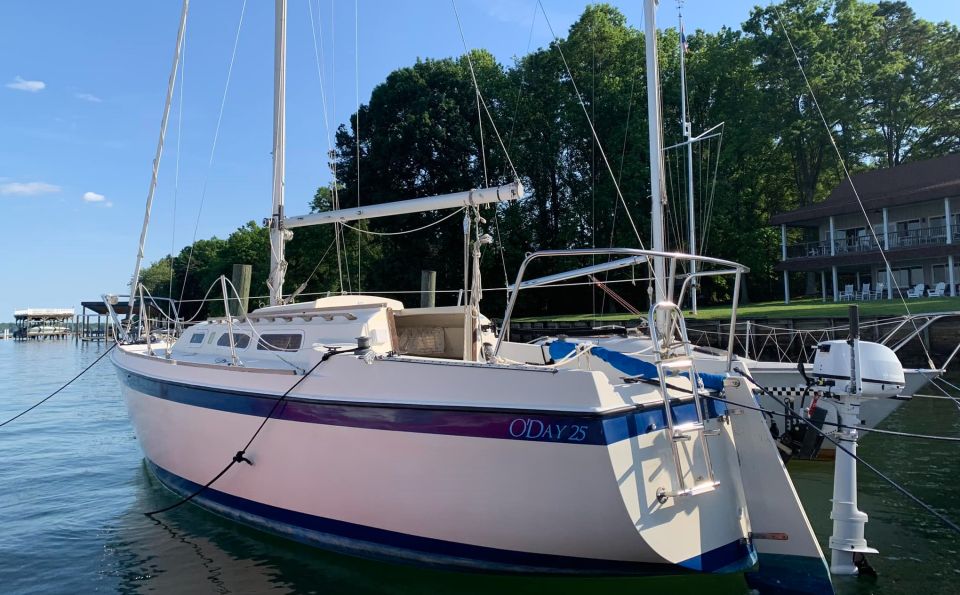
>>Also Read: Best Sailboat Brands
Inside an O’Day: Where Comfort Resides
Beyond the technical aspects, the interiors of O’Day sailboats speak of a dedication to comfort. Practical design ensures maximum space utilization. Ample headroom, cozy berths, and generous storage make them perfect for extended trips. While they might not compete with luxury yachts, the interiors have a charm that exudes warmth and coziness, making every journey memorable.
Value Proposition: Quality at the Right Price
George O’Day’s vision was not just about crafting exceptional sailboats but also about making them accessible. Throughout its history, O’Day’s pricing has reflected this commitment to value. Their boats, especially when compared to some competitors, often came with an appealing price tag. This accessibility has opened the world of sailing to many who might have found other brands prohibitive.
A Thriving Community
Brands that stand the test of time often foster strong communities, and O’Day is a shining example. Owners share a bond forged in the waters and reinforced at marinas, clubs, and online forums. This camaraderie is invaluable for new owners, providing a platform for shared experiences, maintenance tips, and even sailing adventures.
Moreover, the widespread popularity means that service, repairs, and spare parts are easier to find. Even decades after their prime, O’Day sailboats find support, love, and care from a dedicated community.
Limitations: Every Coin Has Two Sides
No review is complete without addressing potential drawbacks. Despite their many strengths, O’Day sailboats may not satiate every sailor’s needs. Some sailors looking for ultra-modern aerodynamics and speed might find them a tad underwhelming. Moreover, given their age, older models can demand significant investment in upgrades or overhauls to align with contemporary standards. However, many purists argue that this is a small price for owning a piece of American sailing history.
Are O’Day Sailboats Good? – The Verdict
O’Day sailboats have firmly anchored themselves in the chronicles of American sailing history. Their emphasis on stability, performance, and affordability made them a favorite among recreational sailors. And while they might not be the epitome of luxury or racing prowess, they undoubtedly offer a balance of quality and value.
O’Day sailboats are more than just vessels; they are narratives, stories of a brand that made sailing an attainable dream for many. Their boats aren’t just machines; they are companions on countless adventures, silent witnesses to the joys, challenges, and thrills of the open waters.
So, are O’Day sailboats good? The answer is nuanced. O’Day might not top your list if you seek modern, high-tech marvels. But if you’re looking for reliable, durable, and historically rich sailboats that offer a blend of performance and value, O’Day stands tall.
In the grand sailing arena, O’Day sailboats have etched their legacy, not just in fiberglass and sailcloth but in the hearts and memories of countless sailors. They represent a chapter in American sailing that speaks of innovation, dedication, and an undying love for the sea. Owning an O’Day is not just about possessing a boat; it’s about holding a fragment of history, a testament to the timeless allure of sailing.
Peter is the editor of Better Sailing. He has sailed for countless hours and has maintained his own boats and sailboats for years. After years of trial and error, he decided to start this website to share the knowledge.
Related Posts

The Ultimate Guide to Choosing the Best Fishing Line for Trolling

Lagoon Catamaran Review: Are Lagoon Catamarans Good?

Best Inboard Boat Engine Brands

Maximizing Comfort on Your Boat: Essential Supplies and Amenities
- Buyer's Guide
- Destinations
- Maintenance
- Sailing Info
Hit enter to search or ESC to close.
- BOAT OF THE YEAR
- Newsletters
- Sailboat Reviews
- Boating Safety
- Sailing Totem
- Charter Resources
- Destinations
- Galley Recipes
- Living Aboard
- Sails and Rigging
- Maintenance
- Best Marine Electronics & Technology

Classic Plastic: O’Day 27
- By Jim Carrier
- Updated: January 7, 2021
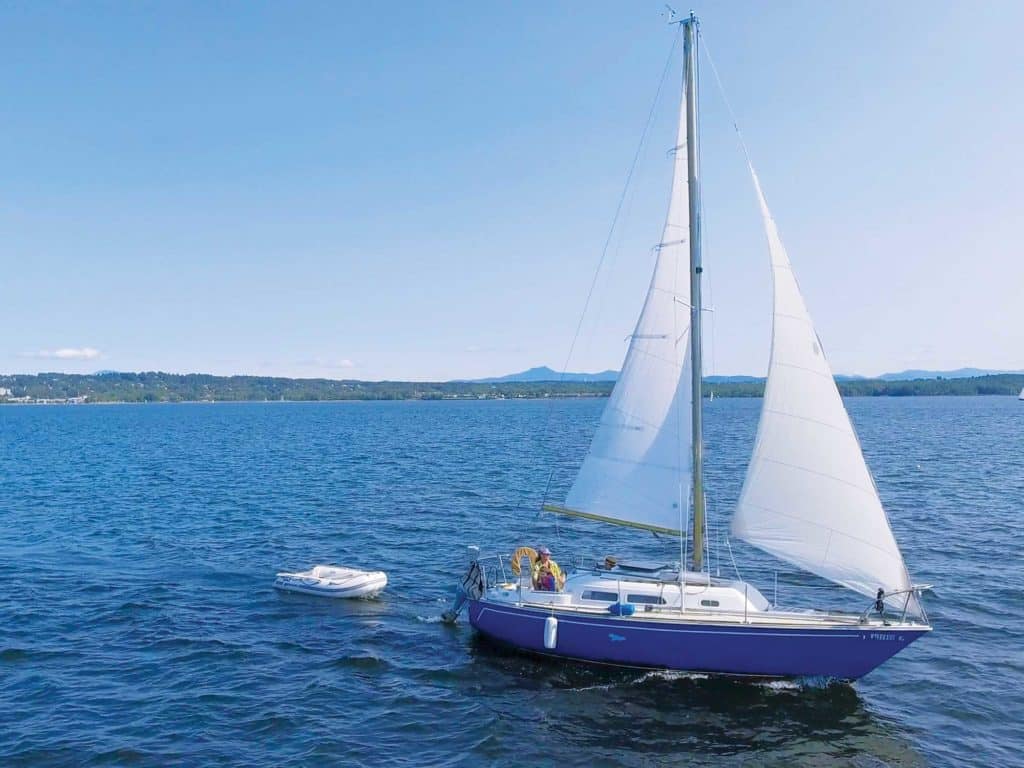
There was a day, before wide screens, all-night buffets and king-size beds, when a family would cruise happily on a boat like the O’Day 27. Solid and simple, the little sloop was just right for lake, harbor or coastal exploring. Small enough for a quick daysail with friends, big enough for a weekend or week gunkholing, the 27 was hugely popular: Between 1972 and 1979, 720 boats were produced at O’Day’s factory in Fall River, Massachusetts.
George O’Day, who founded the company in 1951, wasn’t a cruiser (he won a gold medal at the 1960 Olympics in the 5.5 meter class), but he understood that an uncomplicated sailboat was something a whole family could enjoy.
Alan Gurney designed it. Famous in the high-end yachting world for Windward Passage and other one-off race boats for millionaires, Gurney is said to have worked with what sailing writer Ted Jones called “a seaman’s eye; he thought like the water through which he had sailed.” Commissioned to create an everyman’s sailboat, Gurney sketched a compact, almost blocky hull with a 22-foot-9-inch waterline and 4-foot draft. Half of its 5,000-pound displacement was in the lead keel, which balanced a mast 38 feet above the water, 320-square feet of sail, and the heft to carry a chute or big genoa. The hull was solid, hand-laid fiberglass, with teak brightwork to dress it up. It came equipped with outboard motors or, later, an inboard gas or diesel engine.
Step aboard, as I did on Jonathan Heller’s 1974 O’Day 27, moored on Lake Champlain in Burlington, Vermont, and you will first find a long cockpit with a tiller, an ample entryway and an interior that is surprisingly spacious, due in part to its 9-foot beam, with a fold-up table, stepped mast and 6-plus-foot headroom. According to Jones, writing in Professional Boatbuilder , an O’Day salesman complained about headroom in Gurney’s initial design. Gurney handed him a pencil and “asked him to draw where he thought the headroom should be.” If the cabin “appears to be a bit high,” Jones wrote, “that’s the reason!”
O’Day’s sales brochures for its first keel boat were hyperbolic: a “luxurious cruiser,” “big, airy sleeping accommodations for five,” “a truly superior yacht.” But at a sail-away price of under $7,000, the first O’Day 27s were an instant hit. By the end of their run, they cost $14,500.
By today’s standards, the boat’s galley and head remind me of a small camping trailer—adequate but tight. There’s an icebox, an alcohol stove and an optional shower (if you watch your elbows). One striking compromise is the absence of any anchor hardware. A bow pulpit was standard but nothing on which to hang a hook. Over the years, owners have also had to deal with water intrusion on chainplates.
The good news is that these boats can be had for a song, from $3,900 to $8,000, and that many parts are still available. Heller, a handyman, musician and father of a 3-year-old girl, purchased the boat for $7,000 from a college student who had been living on the hook. Still learning how to sail his yet-unnamed love, he plans to explore Champlain, a cruising ground “big enough to be challenging but not big enough to be scary.” The same could be said of the O’Day 27.
Journalist and author Jim Carrier is a CW contributing editor.
- More: classic plastic , o'day , print dec 2020 , Sailboats
- More Sailboats
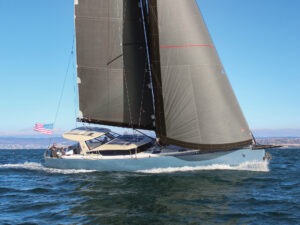
New to the Fleet: Pegasus Yachts 50

Balance 442 “Lasai” Set to Debut

Sailboat Review: Tartan 455

Meet the Bali 5.8
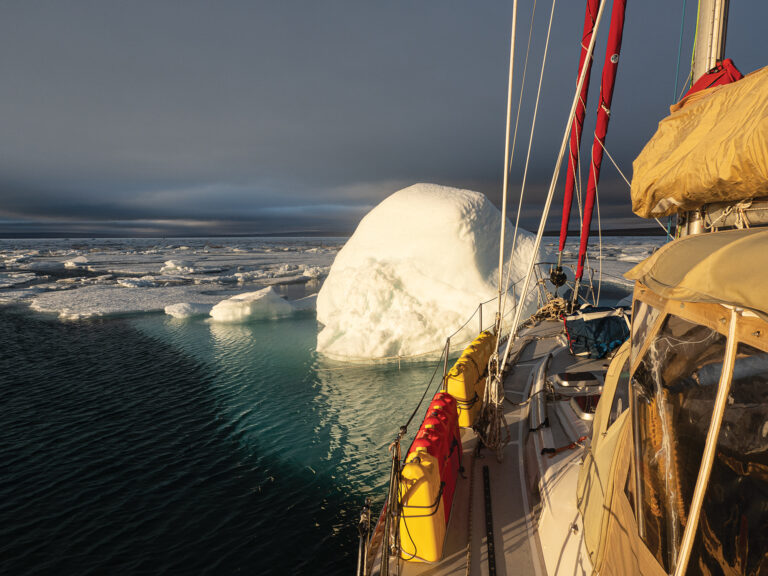
Cruising the Northwest Passage

A Legendary Sail

10 Best Sailing Movies of All Time
- Digital Edition
- Customer Service
- Privacy Policy
- Email Newsletters
- Cruising World
- Sailing World
- Salt Water Sportsman
- Sport Fishing
- Wakeboarding

Are O’day Sailboats Any Good? (Here’s What You Need To Know)

Sailboats have been used for centuries to explore the world’s oceans, lakes, and rivers.
Whether youre a beginner or an experienced sailor, an O’day sailboat may be the perfect choice for you.
In this article, we’ll explore the advantages, types, performance, durability, affordability and uses of O’day sailboats.
We’ll also look at some of the considerations you should take into account when deciding if an O’day sailboat is right for you.
So if youre looking for a reliable, affordable, and versatile sailboat, read on to learn more about O’day sailboats.
Table of Contents
Short Answer
O’Day sailboats are generally well-regarded for their quality and performance.
They have been in production since the 1960s and incorporate modern designs and materials to ensure excellent sailing performance.
The quality of the craftsmanship is reliable and the boats are known for their comfort and ease of use.
O’Day sailboats are a great choice for beginner and experienced sailors alike.
Overview of O’day Sailboats
O’day sailboats are a popular choice among sailing enthusiasts for good reason.
They offer a great combination of performance, durability, and affordability.
The vessels feature an easy-to-use design, with plenty of options to choose from for both recreational sailing and racing.
O’day sailboats are generally known for their stability and speed, and the smaller models are perfect for beginner sailors.
The boats are also very durable, making them a great choice for those looking for a reliable and affordable vessel.
In addition, O’day sailboats are easy to maintain and repair, and are available in a variety of styles and sizes.
From larger vessels suitable for coastal sailing to smaller boats perfect for lake sailing, O’day sailboats have something for everyone.
With their wide range of features and benefits, O’day sailboats are a great choice for those looking for an enjoyable and affordable sailing experience.
Advantages of O’day Sailboats

When it comes to sailboats, there are many different options available and O’day sailboats are one of the most popular choices.
O’day sailboats provide a great balance of speed and stability, making them a great choice for both recreational and competitive sailors alike.
O’day sailboats are also known for their durability and affordability, making them a great choice for those looking for a reliable and budget-friendly vessel.
One of the biggest advantages of O’day sailboats is their performance.
These boats offer excellent performance, allowing sailors to take on challenging conditions with ease.
They are also designed with an easy-to-use layout, making them accessible to beginner sailors.
O’day sailboats are also known for their variety of options, allowing sailors to choose the perfect boat for their needs.
Another great advantage of O’day sailboats is their durability.
These boats are built to last, providing sailors with a reliable vessel that can handle the toughest conditions.
O’day sailboats are also known for their affordability, making them a great choice for those looking for an affordable boat.
Lastly, O’day sailboats are a great option for those looking for a reliable and affordable vessel.
Whether for recreational sailing or racing, O’day sailboats are a great choice for those looking for a reliable and affordable vessel.
Types of O’day Sailboats
O’day sailboats come in a variety of sizes and designs, making them a great choice for sailors of all levels and abilities.
From smaller, more beginner-friendly models to larger racing vessels, there is an O’day sailboat for everyone.
The most popular models include the O’day Mariner, O’day Daysailer, O’day Javelin, and the O’day Rhodes 19.
The O’day Mariner is a great choice for those just starting out in sailing, as it is smaller and easier to handle.
It is also lightweight, making it perfect for daysailing and light cruising.
The O’day Daysailer is a great choice for those looking for a larger sailboat with a more traditional look and feel.
It is perfect for recreational sailing and daysailing.
The O’day Javelin is an ideal choice for racers, as it offers excellent performance and speed.
It is light and easy to maneuver, making it great for competitive sailing.
Finally, the O’day Rhodes 19 is a great choice for those looking for a larger sailboat.
It is known for its durability and reliability, making it perfect for long-distance sailing.
No matter what type of sailing you are interested in, O’day sailboats are an excellent choice.
With a variety of models to choose from, there is an O’day sailboat for everyone.
From smaller beginner-friendly models to larger racing vessels, O’day sailboats provide a great balance of speed, stability, durability, and affordability.
Performance and Stability of O’day Sailboats

When it comes to performance and stability, O’day sailboats have a lot to offer.
The vessels are designed to be fast and agile, making them perfect for a variety of sailing styles.
The boats are also designed with stability in mind, which makes them an excellent choice for both beginner and experienced sailors.
With their wide beam and large keel, O’day sailboats provide great stability in a variety of conditions.
The boats are also incredibly durable, making them ideal for long-term use.
Additionally, the boats are designed to be easy to maneuver, allowing for quick changes in direction when needed.
O’day sailboats are a great choice for those looking for a reliable and responsive boat that can handle a variety of sailing conditions.
Durability and Affordability of O’day Sailboats
When it comes to sailboats, durability and affordability are two of the key factors to consider.
O’day sailboats offer both of these features, making them a popular choice among sailing enthusiasts.
The hulls of O’day sailboats are constructed from a lightweight yet strong fiberglass material, which helps them to last through years of use.
Additionally, the sailboats are designed with an efficient and streamlined shape, which helps to reduce drag and improve performance.
When it comes to affordability, O’day sailboats are one of the most cost-effective options on the market.
The sailboats offer a variety of models to choose from, which makes it easy to find one that fits your budget.
Additionally, the boats come with a variety of features and options that can be customized to meet your needs.
This makes the sailboats a great choice for those looking to get the most value for their money.
Overall, O’day sailboats offer a great combination of durability, affordability, and performance.
With their lightweight yet strong construction, efficient design, and variety of features, O’day sailboats are an excellent choice for those looking for a reliable and affordable vessel.
Whether you’re looking for a recreational sailing boat or a competitive racing boat, O’day sailboats are a great option that won’t break the bank.
Uses for O’day Sailboats

ODay sailboats are incredibly versatile vessels, making them ideal for a variety of uses.
Whether youre a recreational sailor, a competitive racer, or looking for an economical and reliable boat, ODay sailboats are an excellent option.
For recreational sailing, ODay sailboats offer both speed and stability.
Their lightweight construction and easy-to-use design makes them ideal for beginner sailors.
They also come in a variety of sizes, from small day-sailers to larger boats that can be used for week-long trips.
For racing, ODay sailboats offer excellent performance and maneuverability.
Their lightweight construction makes them fast and nimble, and theyre known for their ability to handle rough and choppy waters.
ODay sailboats are also popular in competitive sailing circles, as they are reliable and affordable.
Lastly, ODay sailboats are known for their durability and affordability.
The boats are designed to withstand the rigors of sailing, and are made with quality materials that will last for years.
They are also very affordable, making them a great option for those looking for a reliable and economical vessel.
Overall, ODay sailboats are an excellent choice for anyone looking for a reliable and affordable vessel.
They offer a great balance of speed and stability, and are known for their durability and affordability.
Whether youre looking for a recreational vessel or a competitive racer, ODay sailboats are a great option.
Considerations for Buying an O’day Sailboat
When considering purchasing an Oday sailboat, there are several important factors to keep in mind.
First, budget is a major consideration.
Oday sailboats are typically more cost-effective than other sailboat models, but the features and size of the vessel can greatly affect the final price.
Second, consider the performance characteristics of the boat.
Oday sailboats are known for offering excellent performance, but you may want to consider the size and weight of the boat and the type of sailing you plan to do before making a purchase.
Third, consider the ease of use of the boat.
Oday sailboats are designed for easy handling and come with a variety of options to choose from.
Finally, consider the durability of the boat.
Oday sailboats are known for their ruggedness and reliability, but certain areas of the boat may need more frequent maintenance than others.
Doing your research and considering all of these factors will help ensure that you make the best decision when selecting an Oday sailboat.
Final Thoughts
ODay sailboats offer a great balance of performance, stability, durability, and affordability, making them an excellent choice for all levels of sailing.
Whether youre looking for a recreational sailboat or a competitive racing vessel, ODay sailboats provide a great range of options to suit your needs.
If youre considering buying an ODay sailboat, consider the type of sailing youll be doing, the size of the vessel, and the features and options youll need.
With the right research and some careful consideration, you can find the perfect ODay sailboat for your sailing needs.
James Frami
At the age of 15, he and four other friends from his neighborhood constructed their first boat. He has been sailing for almost 30 years and has a wealth of knowledge that he wants to share with others.
Recent Posts
Does Your Boat License Expire? Here's What You Need to Know
Are you a boat owner looking to stay up-to-date on your license requirements? If so, youve come to the right place! In this article, well cover everything you need to know about boat license...
How to Put Skins on Your Boat in Sea of Thieves? (Complete Guide)
There is a unique sense of pride and accomplishment when you show off a boat you customized to your exact specifications. With Sea of Thieves, you can customize your boat to make it look like your...

- Forum Listing
- Marketplace
- Advanced Search
- About The Boat
- Gear & Maintenance
- SailNet is a forum community dedicated to Sailing enthusiasts. Come join the discussion about sailing, modifications, classifieds, troubleshooting, repairs, reviews, maintenance, and more!
O'Day 272 - thoughts?
- Add to quote
I've seen a few O'Day 272s around for reasonable prices. Wing keel, shoal draft, trailerable (a couple of times a year). These work for me. How about pros and cons? Tender/stiff? Fit and finish? Overall quality? Performance? Keep in mind I'm a weekend cruiser, not looking to round the buoy in record time but sailing close to wind, make 6 knots on a regular basis, that sort of thing.
I have sailed on an O'day 272 on Long Iisland Sound. Because of the shoal draft wing keel it is a bit tender and may require reefing before a deeper keeled boat. This also leads to slightly less pointing ability. The fit & finish of the O 272 I was on was quite nice. The cabin is huge compared to my older 27 footer. The build quality rates about average to good - there are still a lot of O'day sailboats out there (with happy owners). We did an overnight on the O 272 but we grounded the wing keel on a falling tide and could not get the boat off. With a tidal range of about 8' all the water disappeared leaving the boat standing on the wing keel on the sand - a very peculiar sight indeed. After about 6 hours the tide came back in and we floated off. This experience has put me off of the winged keel design somewhat. I think an O 272 could work for you if you can accept the pros & cons of this model.
You can probably get an Oday 30 for about the same price. =-O
Denise, One of the things I am trying to keep in the picture is trailerability. A 30 footer just isn't. A 27 I can get away with but probably not that often. At least to launch and haul home for the long, cold winter. Caleb, Do you really think it tender? My Lancer 25 draws 30". There have been many, and I mean many, times that we have been stick straight while other, lager boats, are heeling like crazy.
don, The winged keel design is very different than your Lancer. You should ask for a sea trial if you are at all concerned about how the boat sails and feels. Your Lancer: LANCER 25 sailboat specifications and details on sailboatdata.com The 272: O'DAY 272 sailboat specifications and details on sailboatdata.com The wing keel 272 "fin" is 2.9' deep that you are dragging around under water. More like a stub than a fin. All I'm saying is that the boat makes a bit of leeway and is a tad tender. If you can live with that it is a good boat for you.
I am hoping to talk somebody local into taking me out on one before I get too deep. I see what you mean. My Lancer's keel is long (fore/aft) where the wing is short in all directions.
We had a 272LE for a few years. We enjoyed the boat, did not find it particularly tender and the overall quality was good. The wing keel had the great benefit of giving us shallow draft that we needed go over a sandbar at low tide. We did run aground in sand a couple of times, and it was not especially hard to get off the sand by kedging. Never tried trailering.
- ?
- 173.9K members
Top Contributors this Month

- Sails & Canvas
- Hull & Structure
- Maintenance
- Sailing Stories
- Sailing Tips
- Boat Reviews
- Book Reviews
- Boats for Sale
- Post a Boat for Sale
- The Dogwatch
- Subscriptions
- Back Issues
- Article Collections
- Free for Sailors
Select Page
O’DAY DAYSAILER II 17
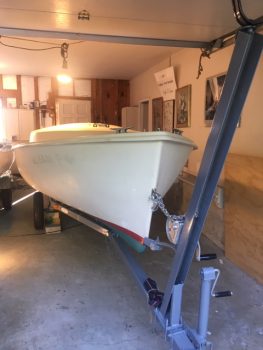
Join Our Mailing List
Get the best sailing news, boat project how-tos and more delivered to your inbox.
You have Successfully Subscribed!
Review of the O'Day Mariner 19 Sailboat
Ahunt/Wikimedia CC 2.0
For over 40 years, the 19-foot Mariner sailboat has been a popular daysailer. Based on the hull of the fast, stable Rhodes 19, the Mariner added a small cabin and other features. Built by O'Day from 1963 through 1979, and currently, by Stuart Marine, the Mariner was marketed as a family daysailer.
As one of the first affordable, trailerable fiberglass sailboats, the Mariner has been popular on lakes and protected bays every since. With its roomy cockpit, wide-beamed stability, and easy sailing characteristics, the Mariner deserves its reputation and is still among the best general-purpose sailboats of its size.
- Excellent boat for learning to sail and for family daysailing
- Stable and handles well if wind or waves kick up
- Very large cockpit provides comfortable sailing for 4 to 6 crew
- Solid and well constructed; older boats have held up well
- Self-righting and positive flotation
- Cabin is useful for daysailing but cramped for sleeping aboard for long
- Older boats susceptible to leaks in centerboard locker (if abused by previous owners)
- Early models lacked self-bailing cockpits

Specifications
- Length overall: 19 feet 2 inches
- Beam: 7 feet
- Draft: keelboat: 3 feet 3 inches - centerboard up: 10 inches - centerboard down: 4 feet 11 inches
- Empty weight: keelboat: 1435 lbs. - centerboard: 1305 lbs.
- Sail area (main and fractional jib): 185 sqft
- Mast height (deck-stepped): 27 feet 10 inches
- Rudder: keelboat: fixed - centerboard: kick-up
- Recommended outboard engine: 2-6 HP
- MSRP $24,000 depending on options - widely available used (NADA Marine Guide average retail price for 1977 models: $2,110)
- Parts readily available for older boats, plus information from owners and class associations
Review of the Mariner 19 Sailboat
In the 1950s the Rhodes 19 was a popular wooden racing and daysailing sailboat. In 1963 Olympic gold-medal sail racer George O'Day bought the hull design, redesigned the topsides with a small cabin, and began producing one of the first affordable fiberglass family sailboats, the Mariner 19. While still producing a keel version, O'Day offered a centerboard option that improved trailer launching and allowed the Mariner to sail up to a beach.
The Mariner rapidly became a popular club one-design racer but also a good family boat seen widely on lakes and bays. By 1979 O'Day had produced almost 3800 Mariners - a huge number for any one model - and after O'Day discontinued the Mariner to focus on larger cruising sailboats, Spindrift and then Stuart Marine continued building the Mariner. The Mariner is still being built - probably the longest continuous production run of any sailboat model ever.
In the late 1960s and 1970s, design changes increased the Mariner's popularity for family sailing. The 2+2 model added two more berths in the cabin, for a total of four, although the cabin really is too cramped to call this boat a cruiser. (Sleeping aboard is more like backpack camping.) The cockpit length was increased to the transom, making a much larger space than in most boats of this size.
The current model includes nonskid on deck and the cockpit seats, all control lines led to the cockpit, positive flotation, and a kick-up rudder on the centerboard model that allows the boat into very shoal waters. With its wide beam and fractional jib that reduces heeling, the Mariner is stable and safe to sail in most conditions.
Virtually all Mariner owners say they'd buy one again - they have no regrets. The features most commonly cited are its stability ("virtually untippable"), its oversized cockpit (where you spend most of your time anyway), and how easily it can be launched (even on a shallow boat ramp).
Perhaps most important, the Mariner is very forgiving of the sailor's mistakes - and thus is an excellent beginning boat. The few complaints of Mariner owners focus on the cramped interior, where the cabin roof is too low for taller people to sit on the settees without bumping your head.
Good Mariners can readily be found on the used market. There are more likely to be problems with an old trailer (rust, wear and tear) than the fiberglass boat itself unless it was abused by a previous owner. For a new owner, The Mariner Class Association offers many benefits, including boat information, sailing tips, sources for parts, and a newsletter.
If you're interested in a small sailboat with a bigger cabin for pocket cruising, check out the West Wight Potter 19 - an outstanding small sailboat. If you’re thinking about a trailerable sailboat like the Potter 19, remember that one of the great advantages is the ability to take it easily to other sailing destinations, such as heading to the Florida Keys in the winter.
Here’s an inexpensive, effective way to control your tiller if you have to let go for a moment while sailing. Need a new outboard motor for your small sailboat? Check out the great new propane-powered outboards from Lehr. If you own a trailer for your boat, be sure you maintain it adequately both to keep it working into the future but to stay safe when using it.
West Wight Potter 19 Sailboat Review
The 8 Best Hoka Shoes of 2024, Tested and Reviewed
Learn the Parts of a Sailboat and How to Communicate Them
Owner's Review of the MacGregor 26 Sailboat Models
Learn How to Sail a Small Sailboat
The 10 Best Towable Tubes of 2024
The 7 Best Travel Car Seats of 2024
How to Rig Your Small Sailboat and Prepare to Sail
The 10 Best Beach Canopies of 2024, Tested and Reviewed
The Best Beach Tents of 2024, Tested and Reviewed
The 12 Best Inflatable Stand-Up Paddleboards of 2024, Tested and Reviewed
The Best From Our Tests: Saucony Endorphin Edge Review
Buying a Sailboat: Sloop vs. Ketch
How to Buy a New Camping Tent
The 11 Best Hardside Luggage Bags of 2024, Tested and Reviewed
Where to Go on a Family Vacation in 2019
- New Sailboats
- Sailboats 21-30ft
- Sailboats 31-35ft
- Sailboats 36-40ft
- Sailboats Over 40ft
- Sailboats Under 21feet
- used_sailboats
- Apps and Computer Programs
- Communications
- Fishfinders
- Handheld Electronics
- Plotters MFDS Rradar
- Wind, Speed & Depth Instruments
- Anchoring Mooring
- Running Rigging
- Sails Canvas
- Standing Rigging
- Diesel Engines
- Off Grid Energy
- Cleaning Waxing
- DIY Projects
- Repair, Tools & Materials
- Spare Parts
- Tools & Gadgets
- Cabin Comfort
- Ventilation
- Footwear Apparel
- Foul Weather Gear
- Mailport & PS Advisor
- Inside Practical Sailor Blog
- Activate My Web Access
- Reset Password
- Customer Service

- Free Newsletter

Ericson 34-2 Finds Sweet Spot

How to Sell Your Boat

Cal 2-46: A Venerable Lapworth Design Brought Up to Date

Rhumb Lines: Show Highlights from Annapolis

Solar Panels: Go Rigid If You have the Space…

Leaping Into Lithium

The Importance of Sea State in Weather Planning

Do-it-yourself Electrical System Survey and Inspection

When Should We Retire Dyneema Stays and Running Rigging?

Rethinking MOB Prevention

Top-notch Wind Indicators

The Everlasting Multihull Trampoline

What Your Boat and the Baltimore Super Container Ship May Have…

Check Your Shorepower System for Hidden Dangers

DIY survey of boat solar and wind turbine systems

What’s Involved in Setting Up a Lithium Battery System?

The Scraper-only Approach to Bottom Paint Removal

Can You Recoat Dyneema?

How to Handle the Head

The Day Sailor’s First-Aid Kit

Choosing and Securing Seat Cushions

Cockpit Drains on Race Boats

Re-sealing the Seams on Waterproof Fabrics

Safer Sailing: Add Leg Loops to Your Harness

Waxing and Polishing Your Boat

Reducing Engine Room Noise

Tricks and Tips to Forming Do-it-yourself Rigging Terminals

Marine Toilet Maintenance Tips

Learning to Live with Plastic Boat Bits
Sailboat reviews.
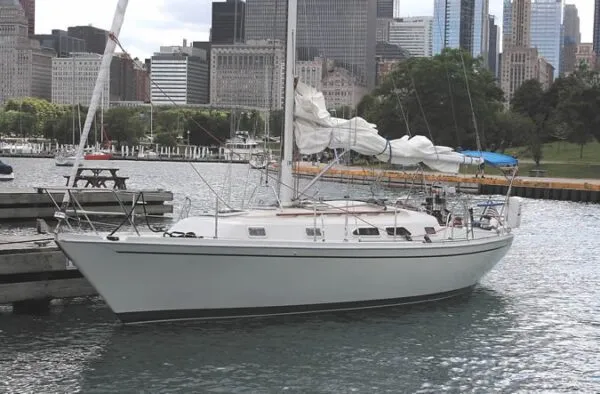
Open Transom Pros and Cons
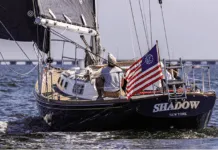
Mailport: Charley Morgan, Locker Safety, Fast Bottom Paint
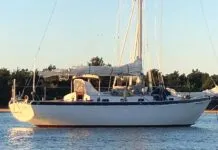
Rebuilding a Cape Dory 36 Part V
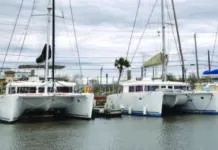
Big Cat Concerns
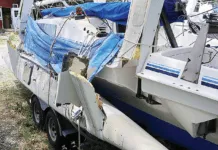
Buying a Used Multihull

Mailport: Propane Hose Chafe, Multihull Prices, Farrier F33XC
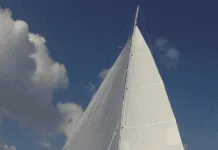
Rebuilding a Cape Dory 36 Part IV
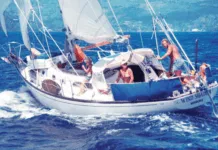
Do You Really Need a Bigger Boat?
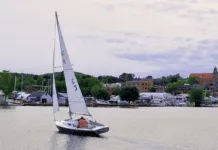
Mailport: Carl Alberg, Tinned Wire, Fiberglass Durability
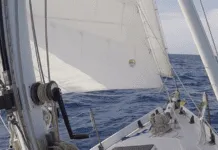
Rebuilding a Cape Dory 36 Part III
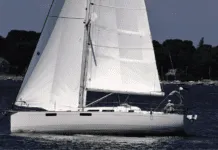
Mailport: X-yachts, Soverel 33, tropical storms
Latest videos.

40-Footer Boat Tours – With Some Big Surprises! | Boat Tour

Electrical Do’s and Don’ts

Bahamas Travel Advisory: Cause for Concern?

Island Packet 370: What You Should Know | Boat Review
- Privacy Policy
- Do Not Sell My Personal Information
- Online Account Activation
- Privacy Manager
- International

Israel-Hamas war

Baltimore Key Bridge collapse
March 26, 2024 - Baltimore Key Bridge collapses after ship collision
By Helen Regan , Kathleen Magramo , Antoinette Radford, Alisha Ebrahimji , Maureen Chowdhury , Rachel Ramirez , Elise Hammond , Aditi Sangal , Tori B. Powell , Piper Hudspeth Blackburn and Kathleen Magramo , CNN
Our live coverage of the Baltimore bridge collapse has moved here .
Crew member on DALI said everyone on board was safe hours after bridge collapse, official says
From CNN’s Amy Simonson
A crew member on the DALI cargo ship sent a message hours after the Francis Scott Key Bridge collapsed Tuesday saying everybody on board was safe, according to Apostleship of the Sea director Andy Middleton.
Middleton, who spent time with the captain of the DALI Monday, told CNN’s Laura Coates he reached out to a crew member after hearing about the incident Tuesday morning.
He said there were 22 members aboard the ship from India who were setting sail earlier Tuesday morning and were heading toward Sri Lanka.
“I was able to reach out to a crew member very early this morning around 5:30 (a.m. ET) or 6 (a.m. ET) and get a message to them asking if they were OK,” he said. “That crew member responded within just a few minutes advising that the crew was safe, and everybody that [was] on board was safe.”
Middleton was told by the ship's captain Monday that the vessel was going to take a longer route to avoid risks along the Yemen coast.
“When I was out with the captain yesterday, we were talking while we were driving, and he advised that they were sailing down and around the tip of South Africa in order to avoid the incidents that are going on off the Yemen coast, and it was a safer way to go,” he said.
Middleton said the Apostleship of the Sea is a ministry to seafarers with members that spend time in the port and on the vessels as a friendly face to the seafarers that visit the Port of Baltimore, “taking care of their needs to make sure that they're reminded of their God-given human dignity when they're here in Baltimore.”
Search operation ends in "heartbreaking conclusion," Maryland governor says. Here's the latest
From CNN staff
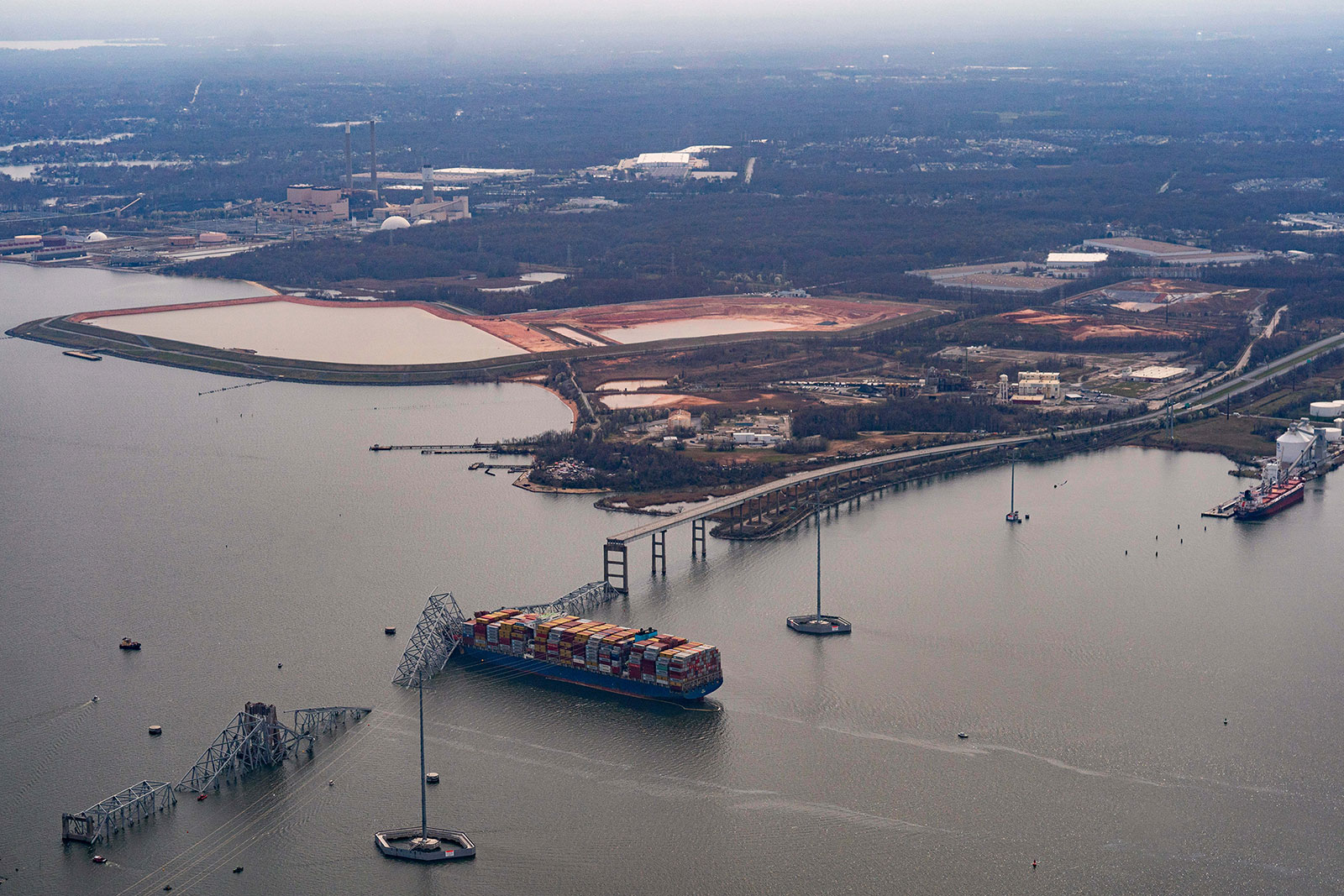
Six people, who were believed to be part of a road construction crew, are presumed dead after Baltimore's Francis Scott Key Bridge collapsed early Tuesday morning. The collapse came after a 984-foot cargo ship hit the bridge's pillar.
Maryland Gov. Wes Moore told reporters Tuesday evening it's a "really heartbreaking conclusion to a challenging day."
Late Tuesday, it was discovered that two of the construction workers who went missing after the bridge collapsed were from Guatemala , the country's Ministry of Foreign Affairs said late Tuesday.
Here's what you should know to get up to speed:
- The victims: Eight people were on the bridge when it fell, according to officials. At least two people were rescued — one was taken to the hospital and was later discharged , fire official and the medical center said.
- The incident: Video shows the moment the entire bridge structure falls into the water, as the ship hits one of the bridge's pillars. CNN analysis shows that the ships lights flickered and it veered off course before it hit the bridge. Maryland Gov. Wes Moore said the crew on the ship were able to issue a "mayday" before colliding into the bridge, which allowed the authorities to stop incoming traffic from going onto the bridge.
- Response efforts: Earlier, dive teams from various state and local agencies were brought in to assist in search-and-rescue operations, according to Maryland State Police Secretary Col. Roland L. Butler Jr.. The mission started with 50 personnel and continued to grow before the Coast Guard announced Tuesday evening that it was suspending its active search-and-rescue operation and transitioning to a "different phase."
- The investigation: Authorities are still working to establish exactly how the crash occurred. The National Transportation Safety Board will look into how the bridge was built and investigate the structure itself. It will "take time to dig through" whether the bridge had ever been flagged for any safety deficiencies , NTSB Chair Jennifer Homendy said.
- Rebuilding the bridge: US Sen. Chris Van Hollen said the path to rebuilding the bridge will be "long and expensive." Senior White House adviser Tom Perez told reporters Tuesday “it’s too early” to tell how long it will take to rebuild the bridge. President Joe Biden said Tuesday he wants the federal government to bear the full cost of rebuilding the collapsed bridge, noting that it will not wait for the company who owns the container ship DALI to shoulder the costs. Funding could come from the Federal Highway Administration as well as the Bipartisan Infrastructure Law, but it may require additional funding from Congress.
2 of the missing construction workers from bridge collapse were from Guatemala, foreign ministry says
From CNN’s Allison Gordon, Flora Charner and Amy Simonson
Two of the construction workers missing from the bridge collapse in Baltimore were from Guatemala, the country's Ministry of Foreign Affairs said in a statement late Tuesday.
Those missing included a 26-year-old originally from San Luis, Petén. The other is a 35-year-old from Camotán, Chiquimula, the statement said.
The ministry said both were part of a work team “repairing the asphalt on the bridge at the time of the accident.”
The statement did not name the two people missing, but it said the country’s consul general in Maryland “went to the area where the families of those affected are located,” where he hopes to be able to meet with the brothers of both missing people.
The consulate also issued a statement Tuesday saying its consul general in Maryland "remains in contact with local authorities," and also confirmed that two of those missing "were of Guatemalan origin.”
Six people, who were believed to be part of a road construction crew, are presumed dead after Baltimore's Francis Scott Key Bridge collapsed early Tuesday morning when a cargo ship hit the bridge's pillar.
State and federal officials have not released information about the identities of any of the six missing workers.
Underwater mapping of bridge collapse area to begin Wednesday, Baltimore fire chief says
From CNN's Jennifer Henderson
Search operations near the Key Bridge collapse have shut down for the night due to dangerous conditions, but the process of underwater mapping with many local, state and federal dive teams will begin Wednesday, Baltimore City Fire Chief James Wallace told CNN’s Anderson Cooper Tuesday night.
Wallace said the portion of the Patapsco River is “tidal influenced, so it goes through tide cycles just like the open waters of the Chesapeake Bay does.”
The water depths in the area under the bridge vary from 40 feet to more than 60 feet, Wallace said. The deeper the divers go, the colder the temperatures they encounter, and the visibility is zero, he added.
Wallace said when crews arrived Tuesday morning, the surface water temperatures of the Patapsco River were about 47 degrees with an air temperature of 44-45 degrees.
Here's what you should know about the historic Francis Scott Key Bridge
The Francis Scott Key Bridge collapsed early Tuesday after a massive container ship lost power and crashed into the iconic Baltimore bridge, sending people and vehicles into the frigid Patapsco River.
Six people, believed to be part of a road construction crew, are presumed dead and the Coast Guard has ended its active search and rescue mission.
Here's what you should know about the historic bridge:
- How old?: The Francis Scott Key Bridge, also referred to as just the Key Bridge, opened to traffic in March 1977 and is the final link in the Baltimore Beltway, according to the Maryland Transportation Authority (MDTA.) It crosses over the 50-foot-deep Patapsco River, where former US attorney Francis Scott Key found inspiration to write the lyrics to the Star Spangled Banner, the MDTA says.
- How long?: The bridge was 1.6 miles long when standing, MDTA reports.
- Traffic volume: More than 30,000 people commuted daily on the bridge, according to Maryland Gov. Wes Moore.
- How much did it cost?: The bridge cost $60.3 million to build, MDTA says. Since its collapse, President Joe Biden said he’s committed to helping rebuild the bridge as soon as possible.
- About the port: Baltimore ranks as the ninth biggest US port for international cargo. It handled a record 52.3 million tons, valued at $80.8 billion, in 2023. According to the Maryland state government, the port supports 15,330 direct jobs and 139,180 jobs in related services.
- About the ship: The bridge collapsed after a container vessel called Dali collided with one of its supports. Dali is operated by Singapore-based Synergy Group but had been chartered to carry cargo by Danish shipping giant Maersk . The ship is about 984 feet long , according to MarineTraffic data. That’s the length of almost three football fields.
Baltimore woman says bridge collapse was "like a piece of family dissolved"
From CNN's Kit Maher
For longtime Baltimore resident, Ceely, who opted not to share her last name, seeing footage of the Francis Scott Key Bridge collapse Tuesday was deeply personal.
“I was very heavy-hearted,” Ceely told CNN. “Very tearful, thinking about the families whose loved ones may be in the water and just remembering when the bridge was constructed, and it was just like a piece of family dissolved.”
Ceely was at a prayer group Tuesday morning when she saw the news. She recalled being afraid when she first crossed the bridge while in Ford Maverick in 1975, but grew to like it because it saved time on the road.
“It was a main artery just like a blood line. It was a main artery to the other side of town. It was awesome. It beat going through the city all the time,” she said.
Elder Rashad A. Singletary , a senior pastor who led Tuesday night’s vigil at Mt. Olive Baptist Church told CNN that many church members watched the bridge's construction.
"It’s a part of the community. A lot of our individuals in our congregation drive that bridge to go to work, and so now it’s really a life changing moment,” he said.
"Heartbreaking conclusion to a challenging day," Maryland governor says as Coast Guard ended search operation
From CNN's Aditi Sangal
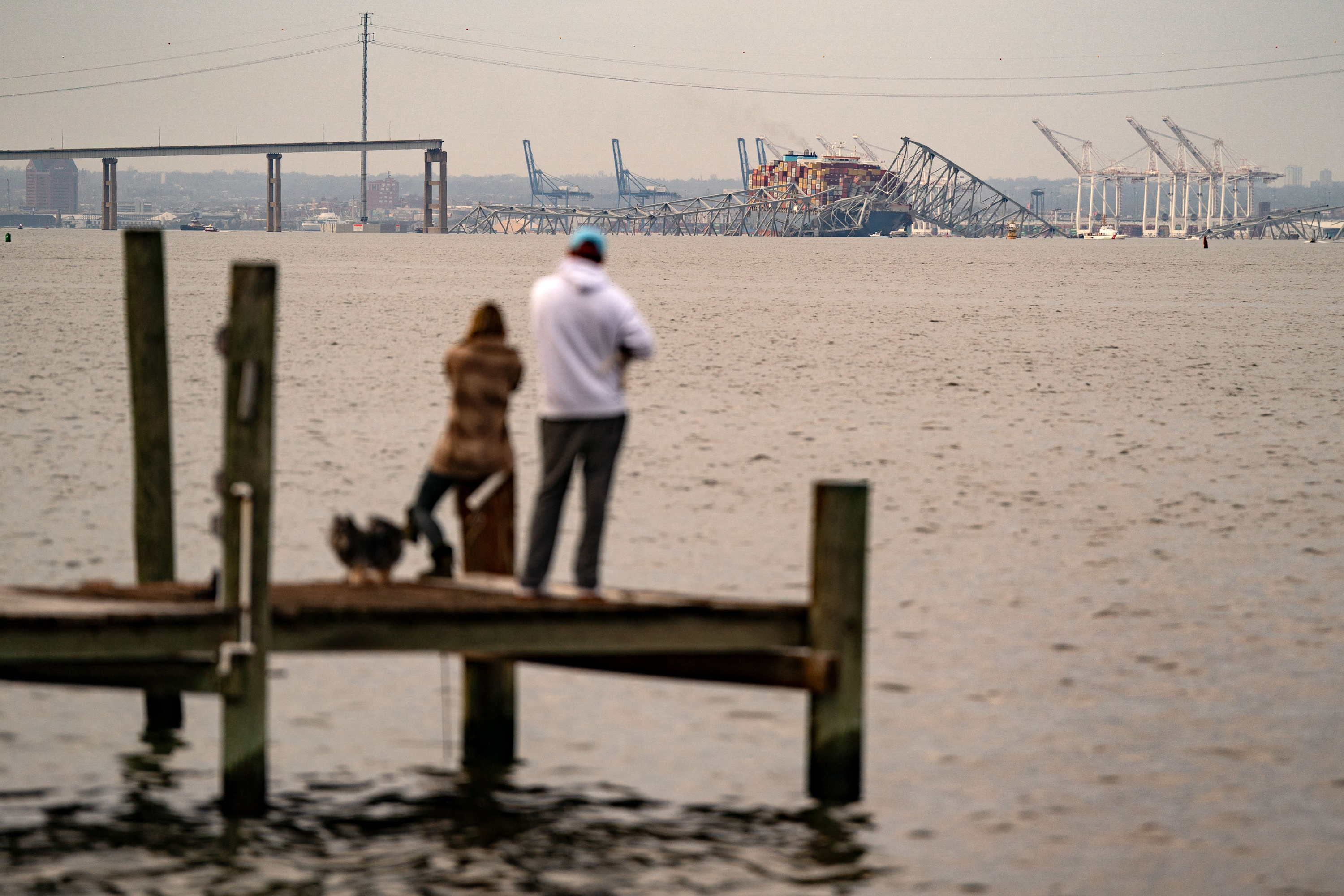
More than 18 hours after the collapse of the Baltimore bridge, Maryland Gov. Wes Moore said it was a heartbreaking conclusion after the Coast Guard ended the search-and-rescue operation for the six people who were on the bridge when it collapsed.
It's a "really heartbreaking conclusion to a challenging day," he said.
"We put every single asset possible — air, land and sea" to find the missing people, he told reporters on Tuesday evening. "While even though we're moving on now to a recovery mission, we're still fully committed to making sure that we're going to use every single asset to now bring a sense of closure to the families," the governor added.
6 people presumed dead after Baltimore bridge collapse, Coast Guard says. Here's what we know
As the sun sets in Baltimore, six people are presumed dead after a major bridge collapsed overnight Tuesday, according to the Coast Guard. The Francis Scott Key Bridge came down around 1:30 a.m. ET after a cargo ship collided with it.
The Coast Guard said it has ended its active search-and-rescue operation for the missing construction workers who were on the bridge when it collapsed.
- What we know: Eight people were on the bridge when it fell, according to officials. At least two people were rescued — one was taken to the hospital and has been discharged . The Coast Guard has been searching for six other people. But, around 7:30 p.m. ET, the Coast Guard said it has transitioned to a “different phase” of operation, now it did “not believe we are going to find any of these individuals alive,” Rear Adm. Shannon Gilreath said.
- About the ship: The bridge collapsed after a container vessel called Dali collided with one of its supports. The vessel is operated by Singapore-based Synergy Group but had been chartered to carry cargo by Danish shipping giant Maersk . The US Embassy in Singapore has been in contact with the country’s Maritime and Port Authority, a State Department spokesperson said.
- The investigation: The National Transportation Safety Board is leading the investigation into the collapse. A team of 24 experts will dig into nautical operations, vessel operations, safety history records, owners, operators, company policy and any safety management systems or programs, said NTSB Chair Jennifer Homendy. A voyage data recorder will be critical to the investigation, she added.
- Vehicles on the bridge: Officials are also working to verify the numbers of how many cars and people were on the bridge, Homendy said. Gov. Wes Moore said the quick work of authorities in closing the bridge had saved lives . Radio traffic captured how authorities stopped traffic and worked to clear the bridge seconds before the impact . Maryland State Police Secretary Col. Roland L. Butler Jr. said there is a “ distinct possibility ” more vehicles were on the bridge, but authorities have not found any evidence to support that.
- Looking ahead: NTSB will look into how the bridge was built and investigate the structure itself, including if it was flagged for any safety deficiencies , Homendy said. The federal government has also directed its resources to help with search and rescue, to reopen the port and rebuild the bridge, Vice President Kamala Harris said . Earlier, President Joe Biden said t he federal government will pay to fix the bridge.
- The economy: Transportation Secretary Pete Buttigieg warned the collapse will have a serious impact on supply chains . Until the channel is reopened, ships will likely already be changing course for other East Coast ports. Ocean carriers are already being diverted from the Port of Baltimore, where the bridge collapsed, to the Port of Virginia to “keep trade moving."
Please enable JavaScript for a better experience.
Watch CBS News
How to travel around the Francis Scott Key Bridge collapse in Baltimore: A look at the traffic impact and alternate routes
By Rohan Mattu
Updated on: March 29, 2024 / 5:01 AM EDT / CBS Baltimore
BALTIMORE -- The collapse of the Francis Scott Key Bridge in Baltimore early Tuesday led to a major traffic impact for the region and cut off a major artery into and out of the port city.
A bridge column was hit by a large container ship around 1:30 a.m., sending bridge workers and vehicles into the Patapsco River. A water search for six missing workers turned to a recovery effort Tuesday night.
Drivers are told to prepare for extra commuting time until further notice.

Alternate routes after Francis Scott Key Bridge collapse
Maryland transit authorities quickly put detours in place for those traveling through Dundalk or the Curtis Bay/Hawkins Point side of the bridge. The estimated 31,000 who travel the bridge every day will need to find a new route for the foreseeable future.
The outer loop I-695 closure shifted to exit 1/Quarantine Road (past the Curtis Creek Drawbridge) to allow for enhanced local traffic access.
The inner loop of I-695 remains closed at MD 157 (Peninsula Expressway). Additionally, the ramp from MD 157 to the inner loop of I-695 will be closed.
Alternate routes are I-95 (Fort McHenry Tunnel) or I-895 (Baltimore Harbor Tunnel) for north/south routes.
Commercial vehicles carrying materials that are prohibited in the tunnel crossings, including recreation vehicles carrying propane, should plan on using I-695 (Baltimore Beltway) between Essex and Glen Burnie. This will add significant driving time.

Where is the Francis Scott Key Bridge?
The Key Bridge crosses the Patapsco River, a key waterway that along with the Port of Baltimore serves as a hub for East Coast shipping.
The bridge is the outermost of three toll crossings of Baltimore's Harbor and the final link in Interstate 695, known in the region as the Baltimore Beltway, which links Baltimore and Washington, D.C.
The bridge was built after the Baltimore Harbor Tunnel reached capacity and experienced heavy congestion almost daily, according to the MDTA.
Tractor-trailer inspections
Tractor-trailers that now have clearance to use the tunnels will need to be checked for hazardous materials, which are not permitted in tunnels, and that could further hold up traffic.
The MDTA says vehicles carrying bottled propane gas over 10 pounds per container (maximum of 10 containers), bulk gasoline, explosives, significant amounts of radioactive materials, and other hazardous materials are prohibited from using the Fort McHenry Tunnel (I-95) or the Baltimore Harbor Tunnel (I-895).
Any vehicles transporting hazardous materials should use the western section of I-695 around the tunnels, officials said.
Rohan Mattu is a digital producer at CBS News Baltimore. Rohan graduated from Towson University in 2020 with a degree in journalism and previously wrote for WDVM-TV in Hagerstown. He maintains WJZ's website and social media, which includes breaking news in everything from politics to sports.
Featured Local Savings
More from cbs news.
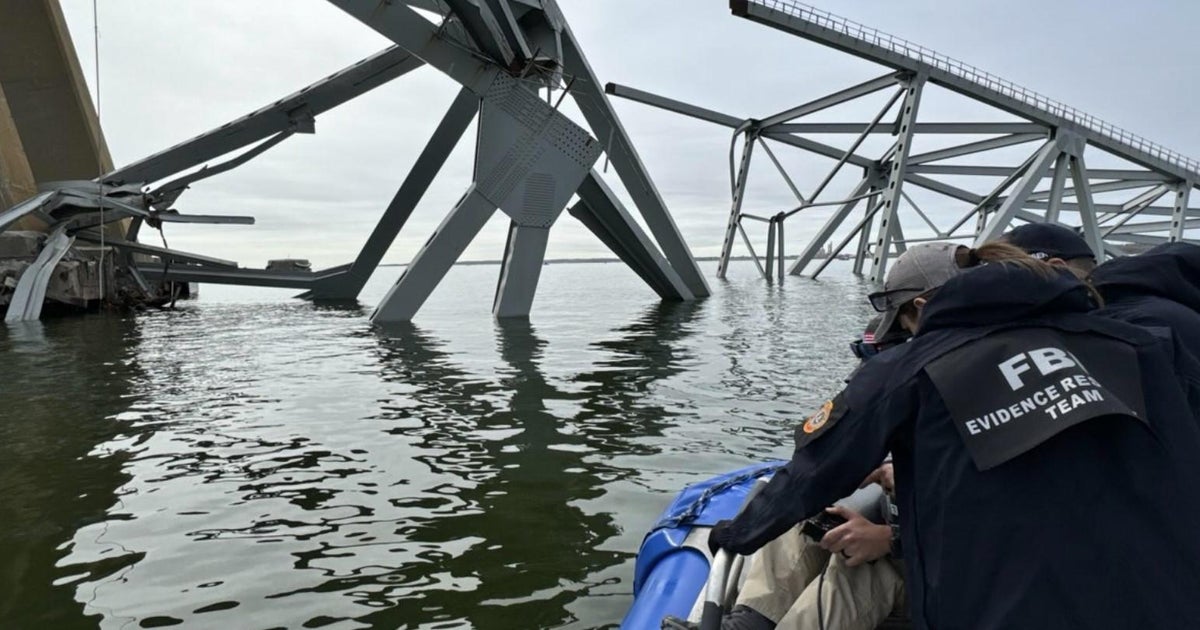
Who are the victims in Baltimore's Francis Scott Key Bridge collapse?
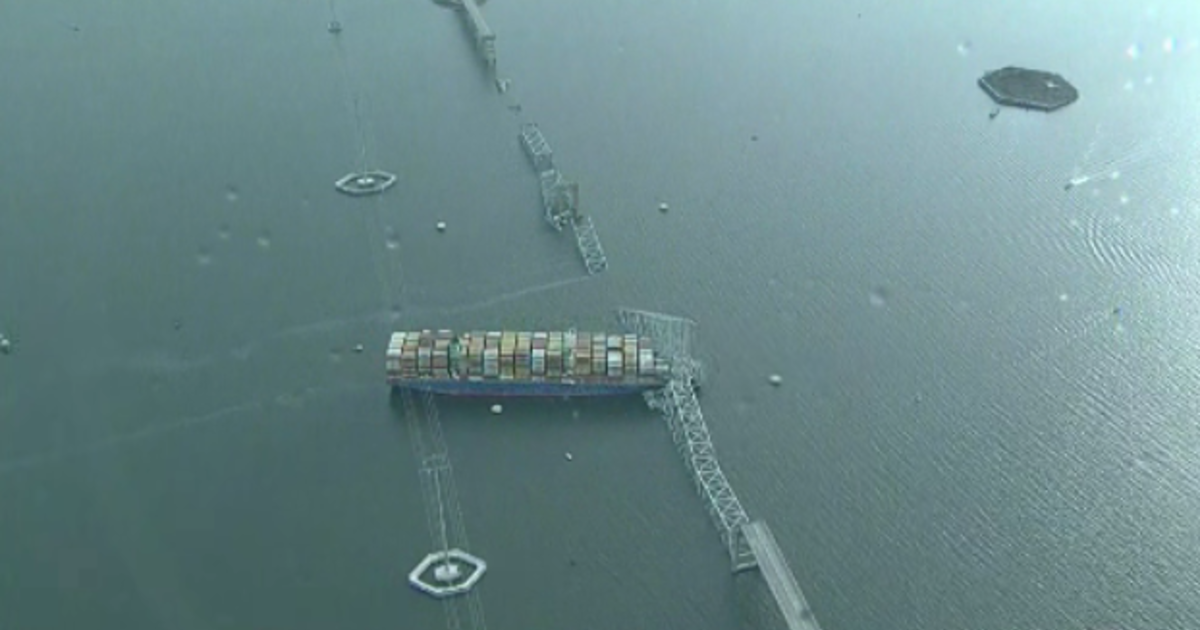
What we know about search and rescue efforts at Francis Scott Key Bridge collapse site
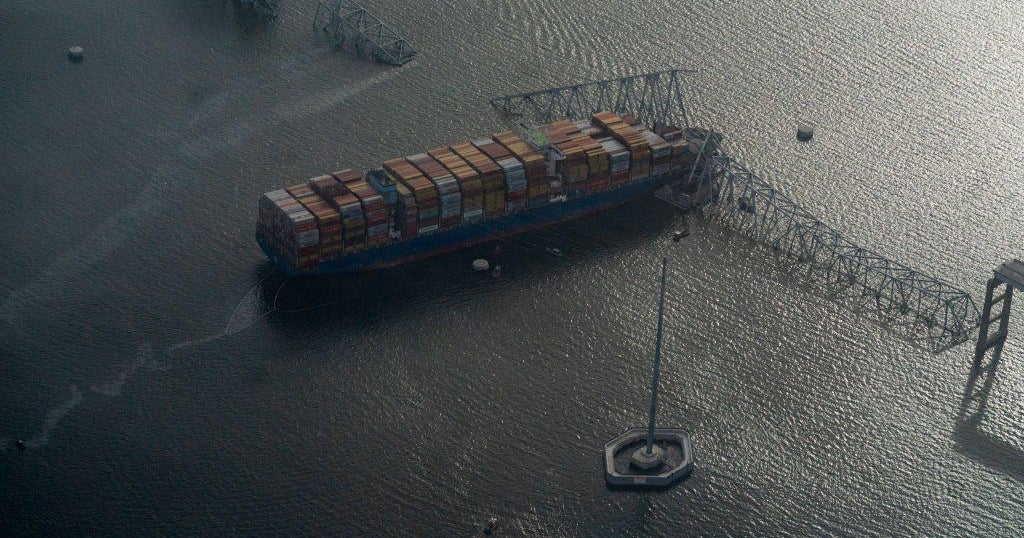
Two bodies recovered from vehicle underwater at Francis Scott Key Bridge collapse site

Francis Scott Key Bridge collapses in Baltimore after ship strike, residents react

IMAGES
VIDEO
COMMENTS
Been looking for used sailboats and came across these two options listed in some local papers.. 1980 CL16 (C&L Boatworks), which seems to be a version of the "Wayfarer". 1984 O'Day 17 Daysailer. Thoughts on pros/cons of these two boats for my needs... as long as their condition is reasonable.. prices are similar.. around $2K with a trailer..
The resulting Day Sailer was a 16'9" centerboarder with a displacement of 575 lbs, which makes for a light load to tow behind the family car. The fractional sloop rig includes a generously sized spinnaker for exciting downwind sailing.The first Day Sailer was sold in 1958 and immediately became popular in the recreational and racing markets.
Mar 20, 2004. 1,729. Hunter 356 and 216 Portland, ME. May 29, 2017. #8. something is very wrong with what you've got - John may be onto something, and you've got a pieced together rig. The DS has had essentially the same spec's it's entire life (I've owned and raced 3), and the boom is high for a 17 footer.
Up to four can sail together and at the end of the day, you can store it on a trailer in your garage. ... the NorseBoat 17.5 is a performance boat whether human or wind-powered that features two rowing stations and lots of room to stow stuff. ... Boat Reviews. Best Daysailers, 20 Feet and Up. Zuzana Prochazka. August 14, 2017.
The DAYSAILER was a collaboration of Uffa Fox & George O'Day. Fox designed the hull, but the original cuddy was designed & molded by O'Day & his company. The DAY SAILER has been built by several builders and with a number of changes along the way but the basic hull design has remained the same. The DAY SAILER II was introduced in 1971 as an ...
In this comprehensive review, we dissect what makes these boats unique and ask the central question: Are O'Day sailboats worth the hype? Genesis: The Birth of a Legacy. Understanding O'Day requires a trip back in time. Founded in 1958 by Olympic sailor George O'Day, the brand's inception was rooted in a clear vision: produce competitive ...
Turtle it and recover from that. After do it on the Laser, your fear will be mostly gone. The Daysailor will be harder, but you will be less panicky and in more of a problem-solving mode. In Jr. Sailing programs the world over, 'capsize day' is the funnest day of the year. Go have fun! 1.
O'Day's sales brochures for its first keel boat were hyperbolic: a "luxurious cruiser," "big, airy sleeping accommodations for five," "a truly superior yacht.". But at a sail-away price of under $7,000, the first O'Day 27s were an instant hit. By the end of their run, they cost $14,500. By today's standards, the boat's ...
O'Day sailboats are generally well-regarded for their quality and performance. They have been in production since the 1960s and incorporate modern designs and materials to ensure excellent sailing performance. The quality of the craftsmanship is reliable and the boats are known for their comfort and ease of use.
By. Darrell Nicholson. -. Published: June 14, 2000 Updated: April 14, 2020. 1. O'Day Boats was around a long time by fiberglass boatbuilding standards—about 30 years. Originally O'Day was a leader in small boats typified by the Fox-designed Day Sailer. O'Day 22 Specifications. By the early '70s O'Day had moved into the trailerable ...
Your Lancer: LANCER 25 sailboat specifications and details on sailboatdata.com The 272: O'DAY 272 sailboat specifications and details on sailboatdata.com The wing keel 272 "fin" is 2.9' deep that you are dragging around under water. More like a stub than a fin. All I'm saying is that the boat makes a bit of leeway and is a tad tender.
Sailboat Reviews; Sailboats 21-30ft; O'Day 30 With good performance, low maintenance, and a big interior, the 30 is a good coastal cruiser. By. Darrell Nicholson - Published: June 14, 2000 Updated: October 26, 2021. 2. Facebook. Twitter. Email. Print. The first O'Day 30 we saw back in 1977 was named Moby Dick. Compared to most of the boats ...
For comparison, the J/35, an extremely popular and successful racer/cruiser of about the same era, has a displacement/ length ratio of 165 and a sail area/displacement ratio of 21.8. While O'Day's numbers certainly don't reflect an all out racer/cruiser, none the less, the 34/35 is a decent performer and, when well equipped and sailed, is ...
Anniversary model. Racer/Daysailer. The boat has been meticulously restored to like new condition. Ready to win races! A completely refurbished trailer is included w/new custom expanded bed for over the road use. Equipment includes a like new North Sails jib/spinnaker. Main in excel cond. 50 ft of chain/nylon rode plus anchor, mainsail cover ...
For over 40 years, the 19-foot Mariner sailboat has been a popular daysailer. Based on the hull of the fast, stable Rhodes 19, the Mariner added a small cabin and other features. Built by O'Day from 1963 through 1979, and currently, by Stuart Marine, the Mariner was marketed as a family daysailer. As one of the first affordable, trailerable ...
The Day Sailor's First-Aid Kit. Mailport & PS Advisor; Inside Practical Sailor Blog. Waxing and Polishing Your Boat ... Home Sailboat Reviews. Sailboat Reviews. How to Sell Your Boat. March 12, 2024. Cal 2-46: A Venerable Lapworth Design Brought Up to Date. Rhumb Lines: Show Highlights from Annapolis. Open Transom Pros and Cons. Mailport ...
Al Drago/Bloomberg/Getty Images. Six people, who were believed to be part of a road construction crew, are presumed dead after Baltimore's Francis Scott Key Bridge collapsed early Tuesday morning ...
The estimated 31,000 who travel the bridge every day will need to find a new route for the foreseeable future. The outer loop I-695 closure shifted to exit 1/Quarantine Road (past the Curtis Creek ...